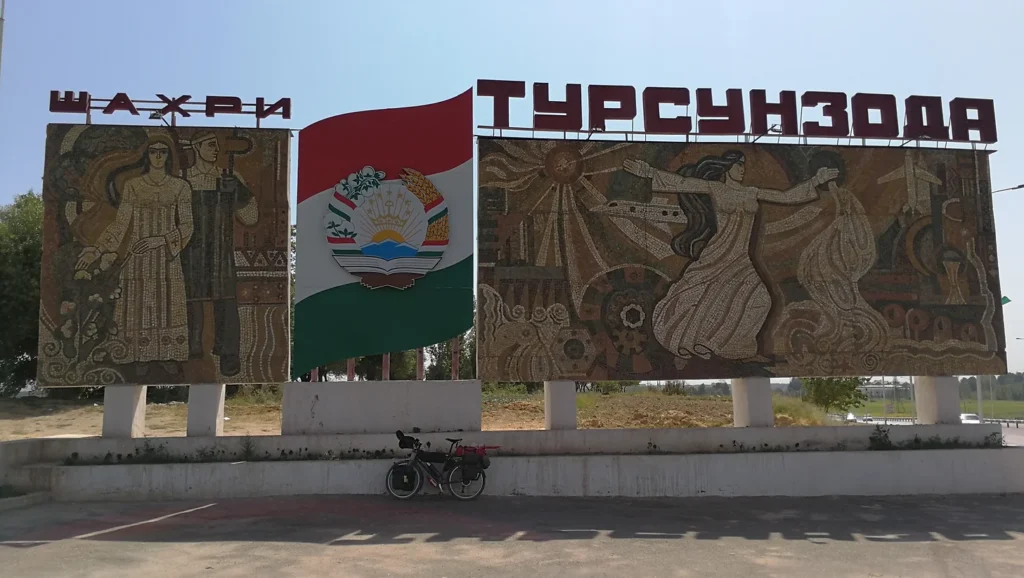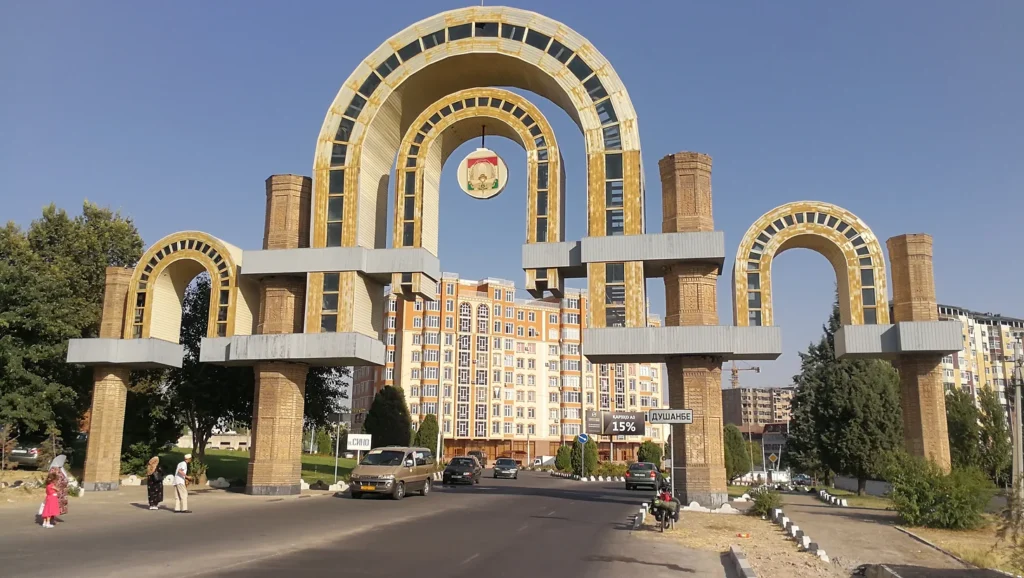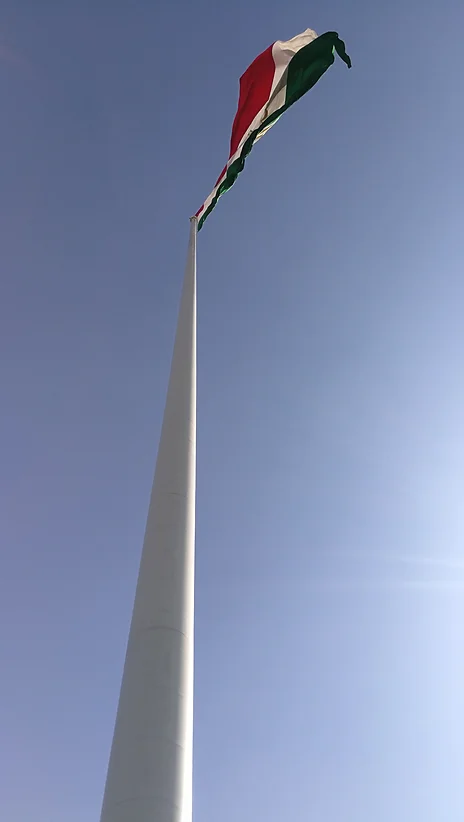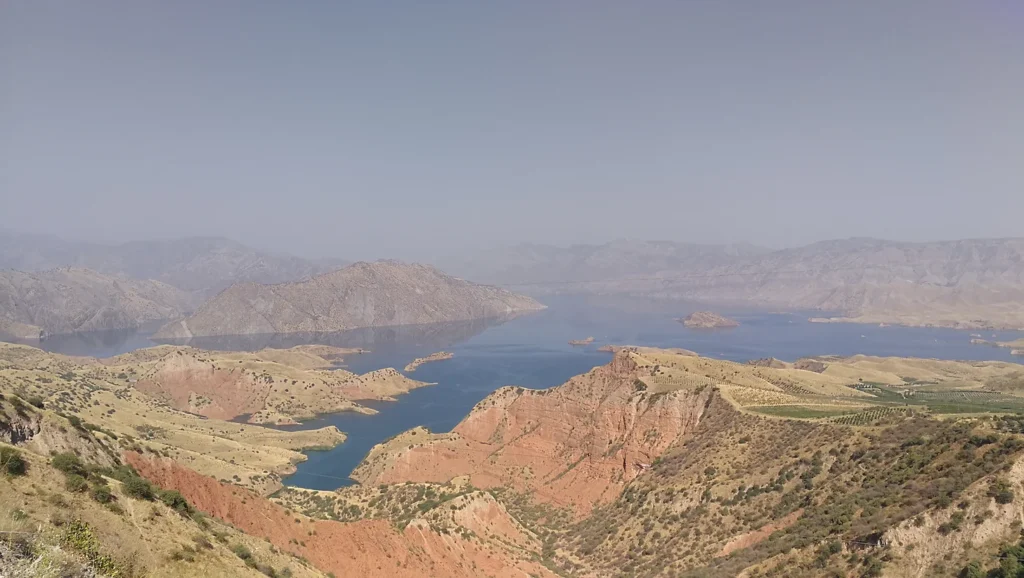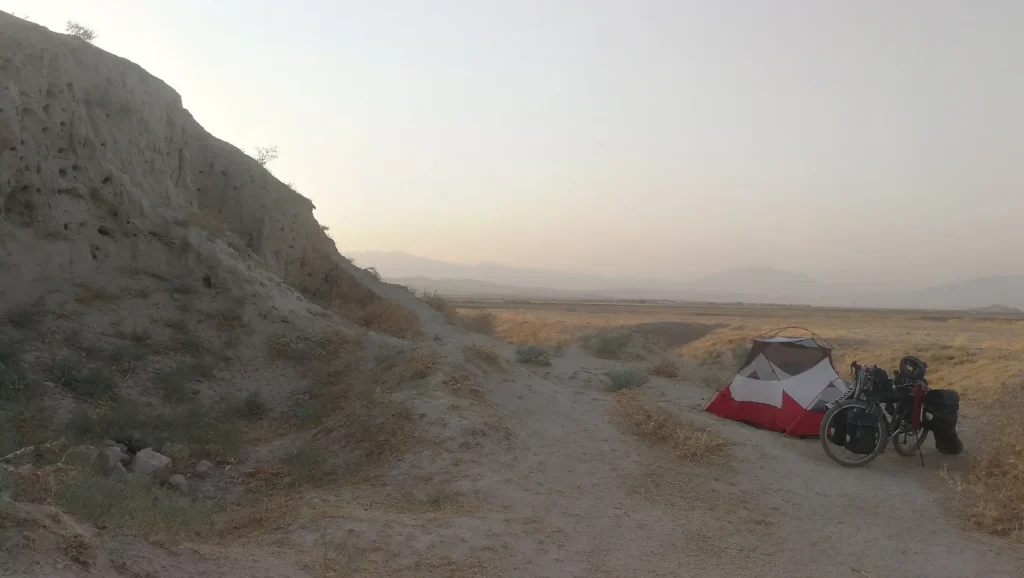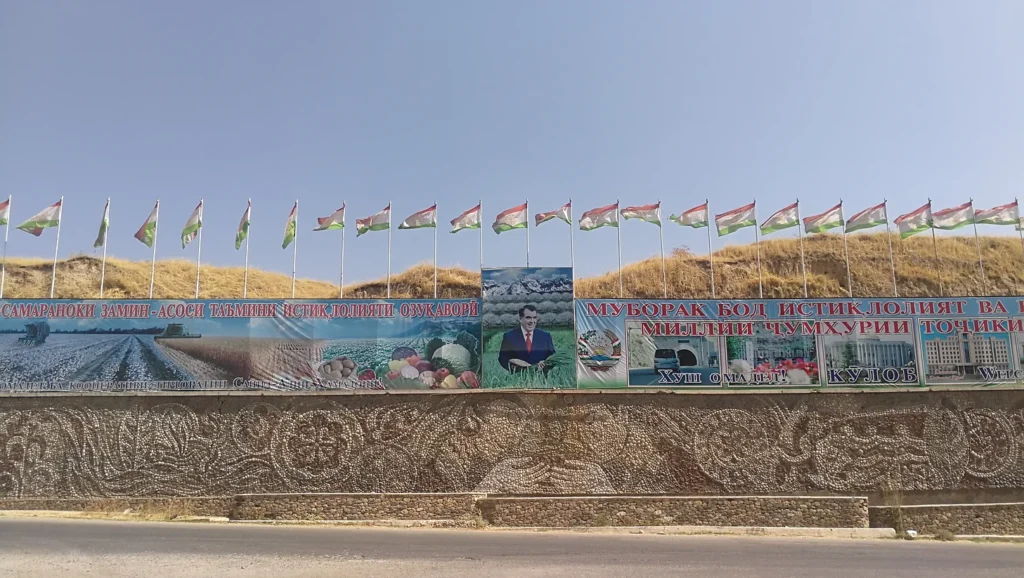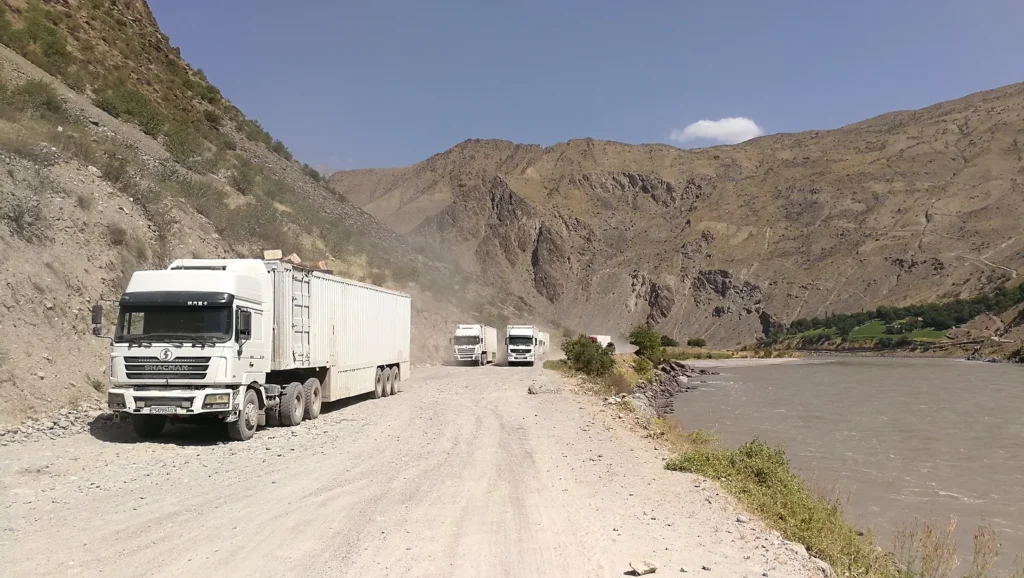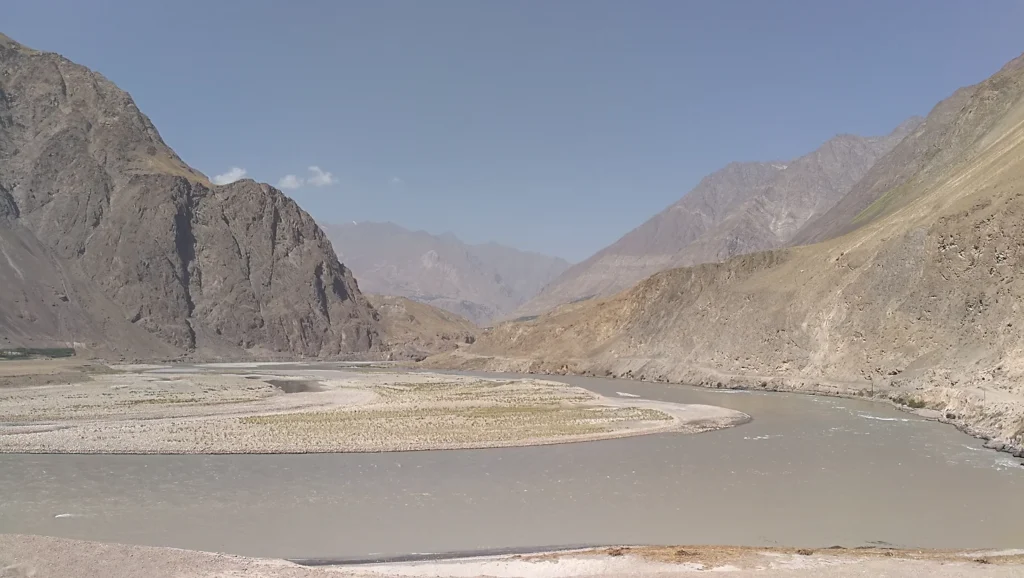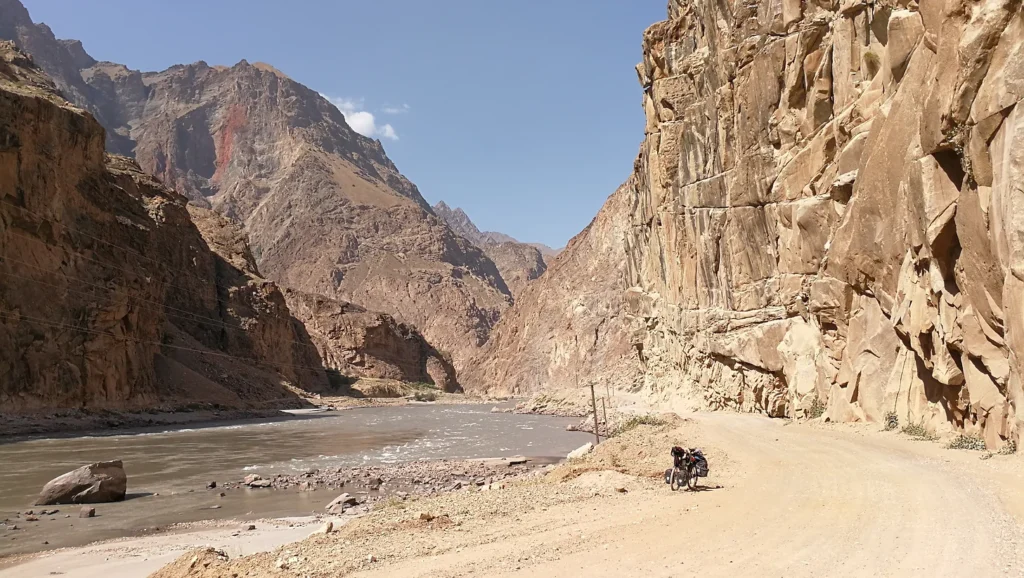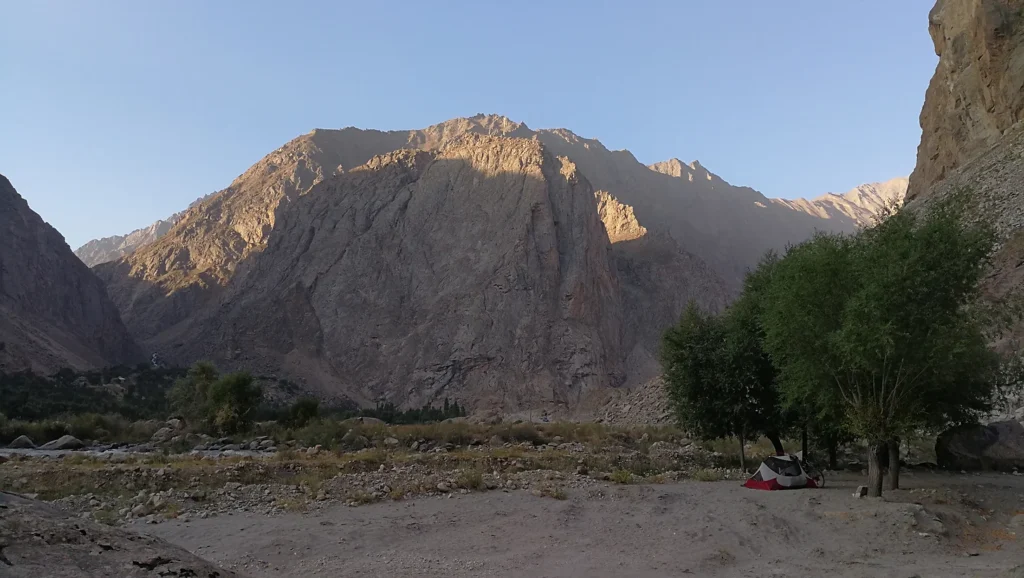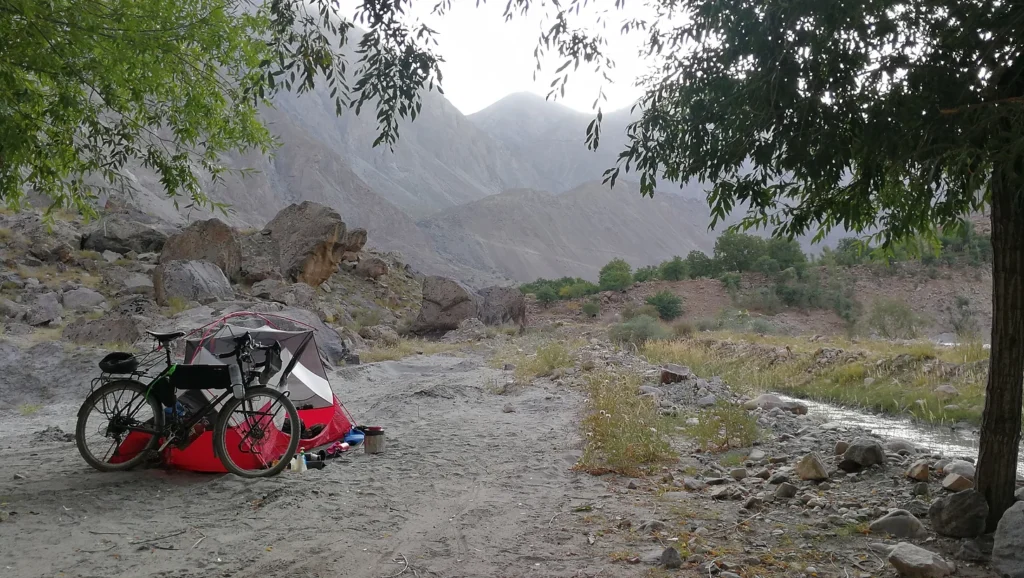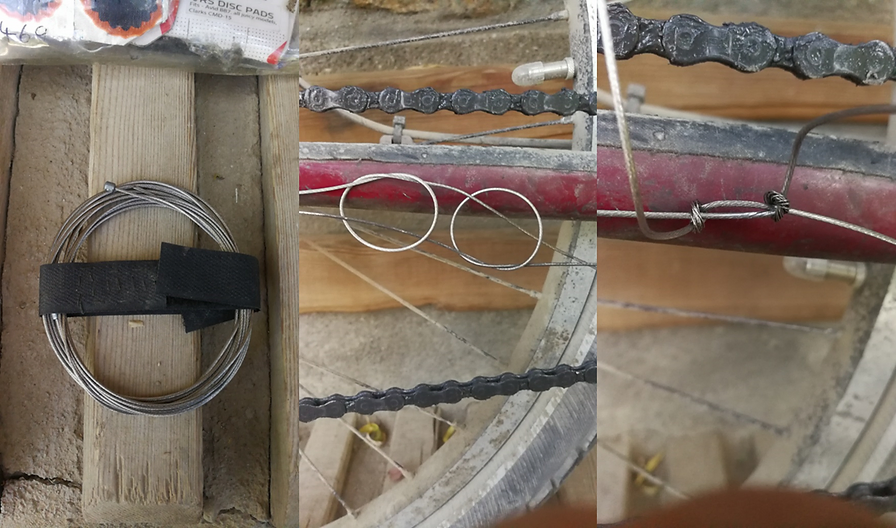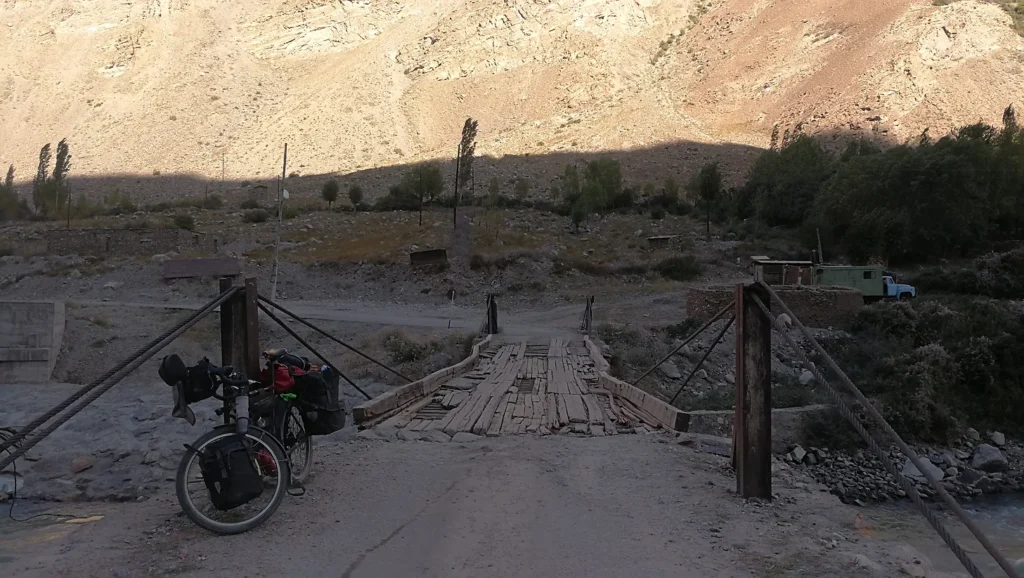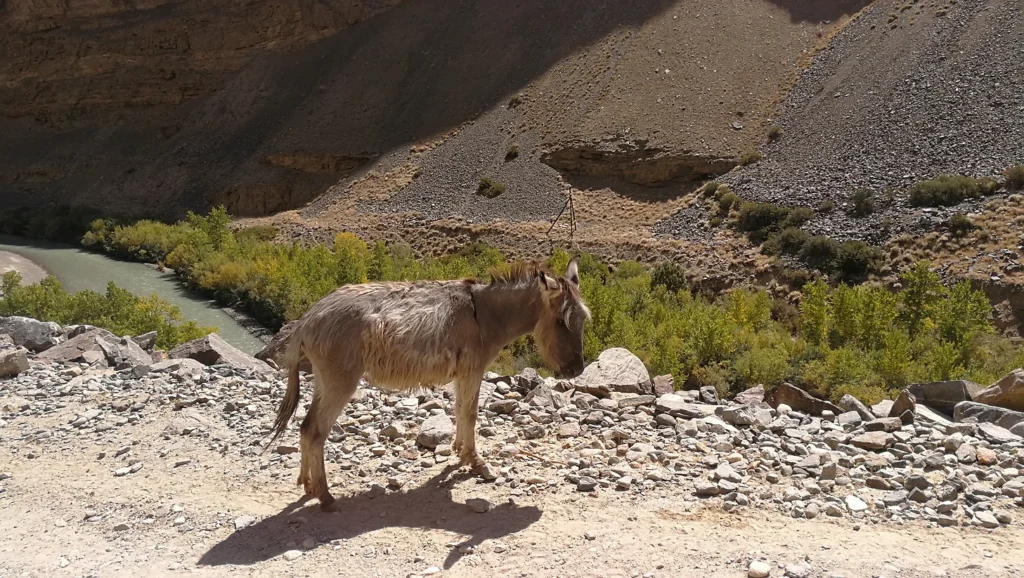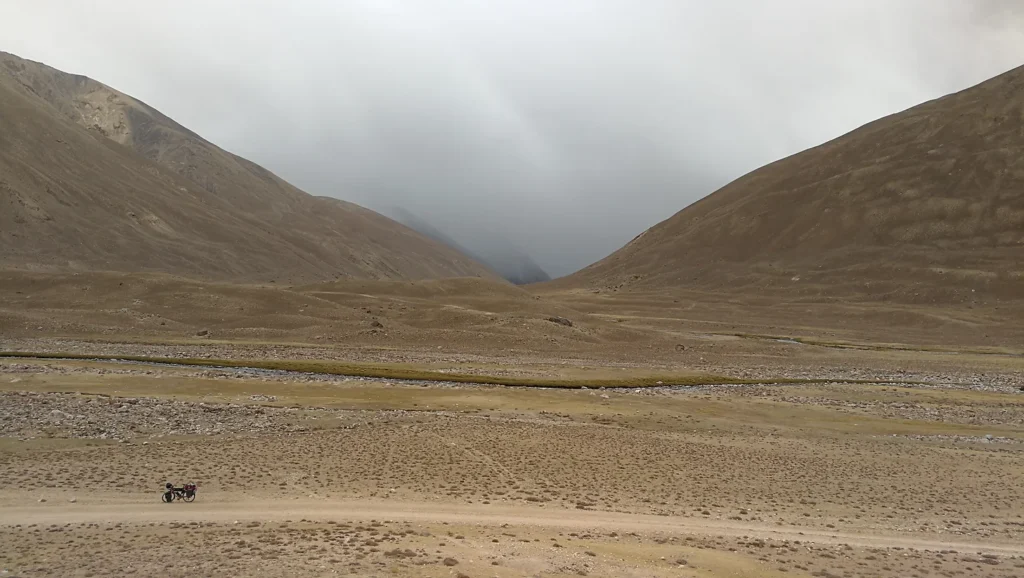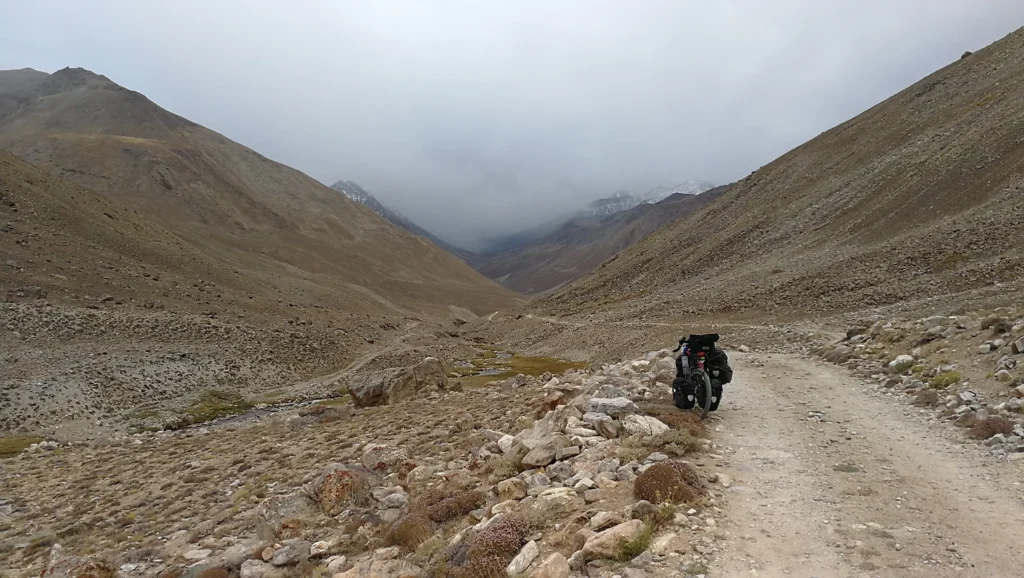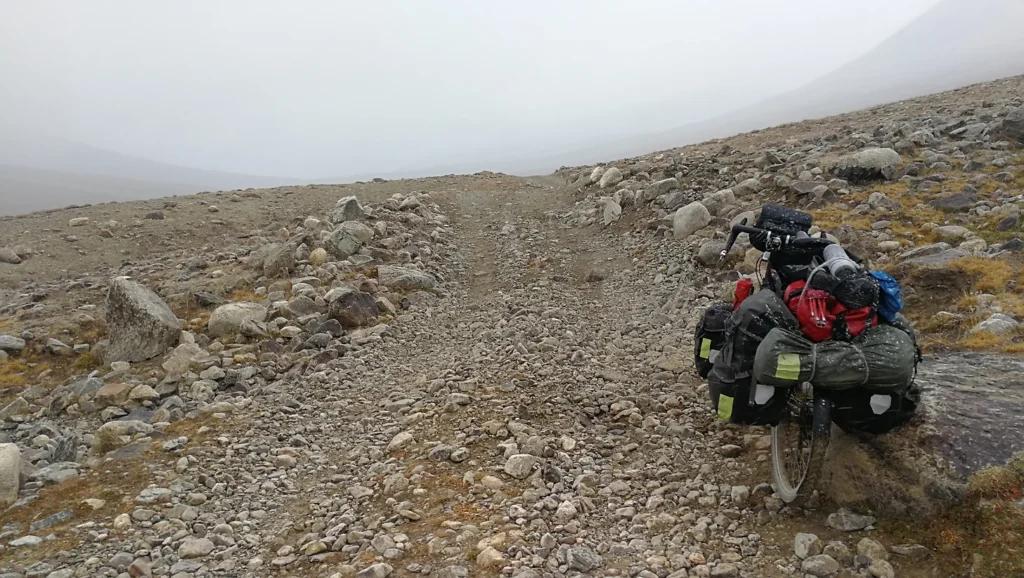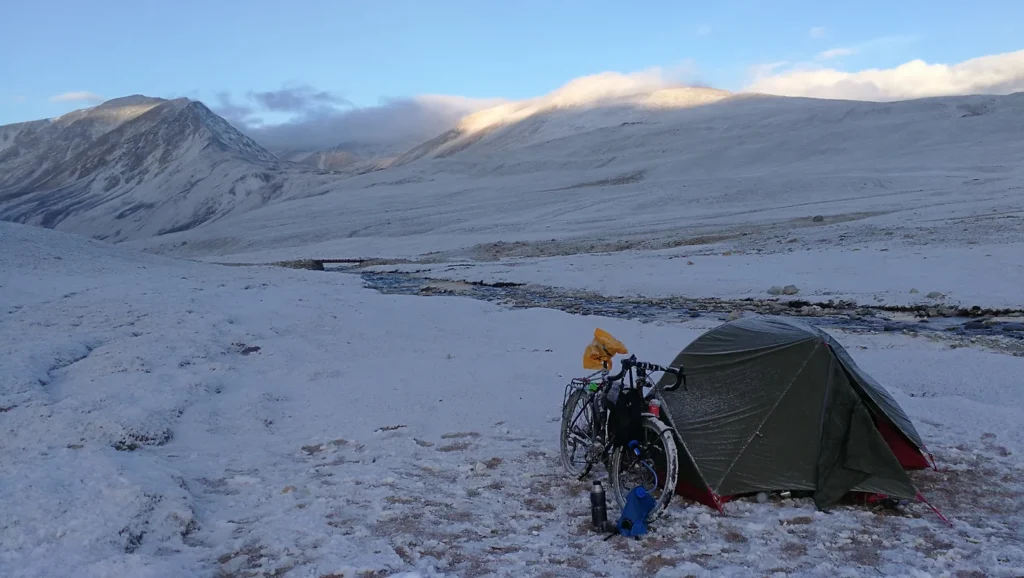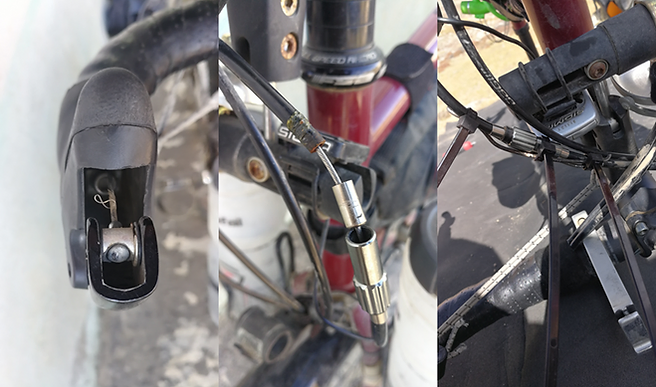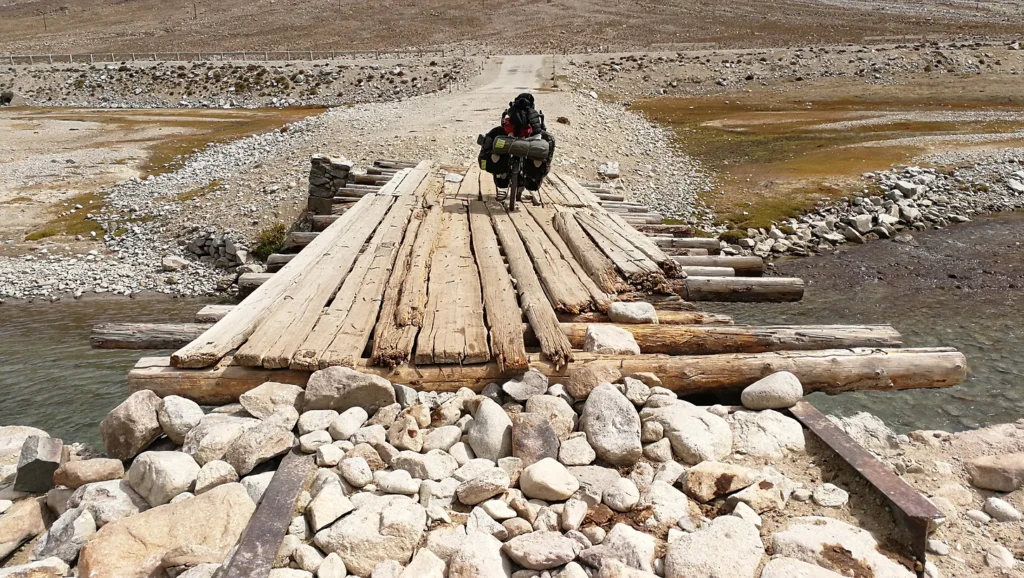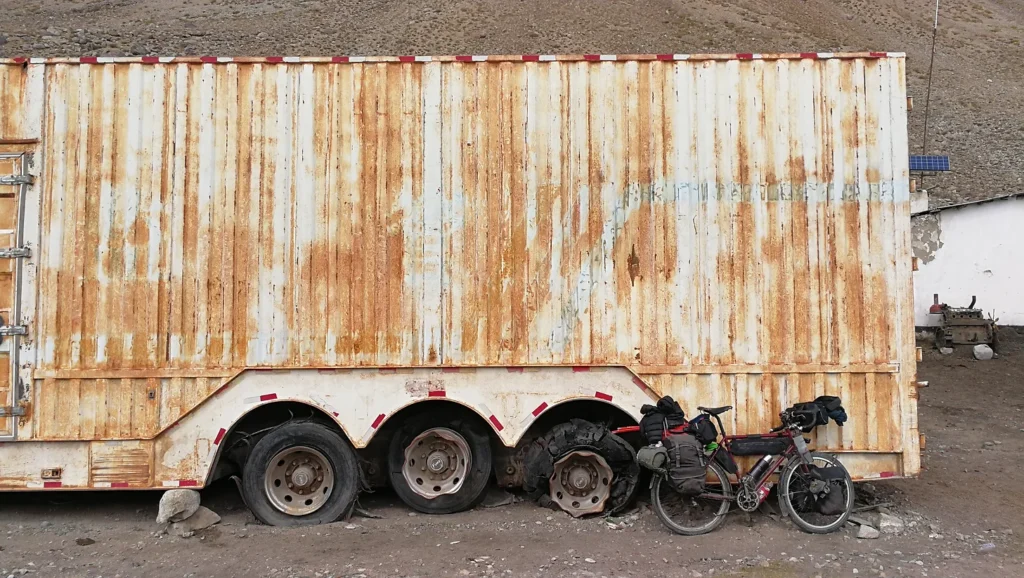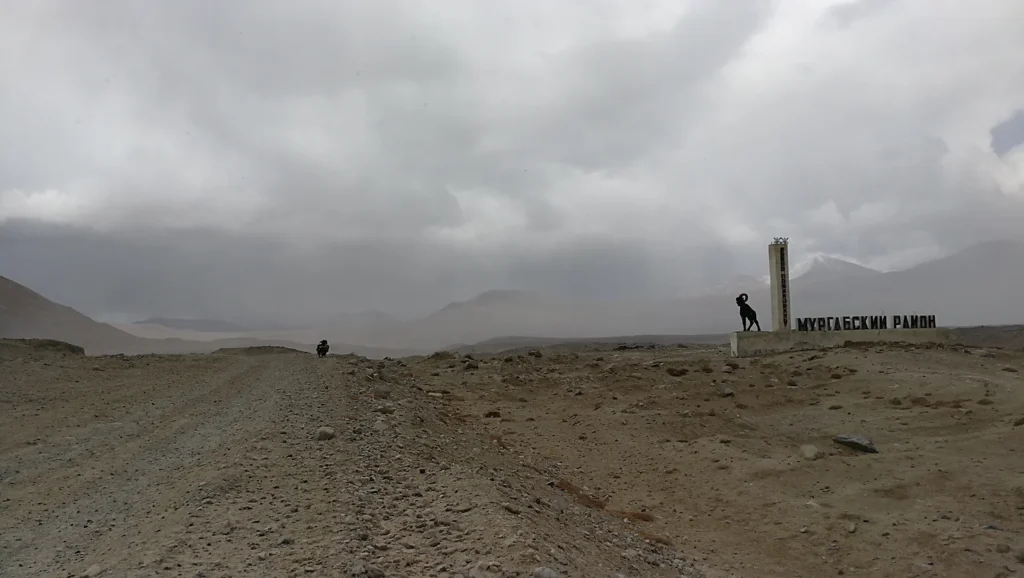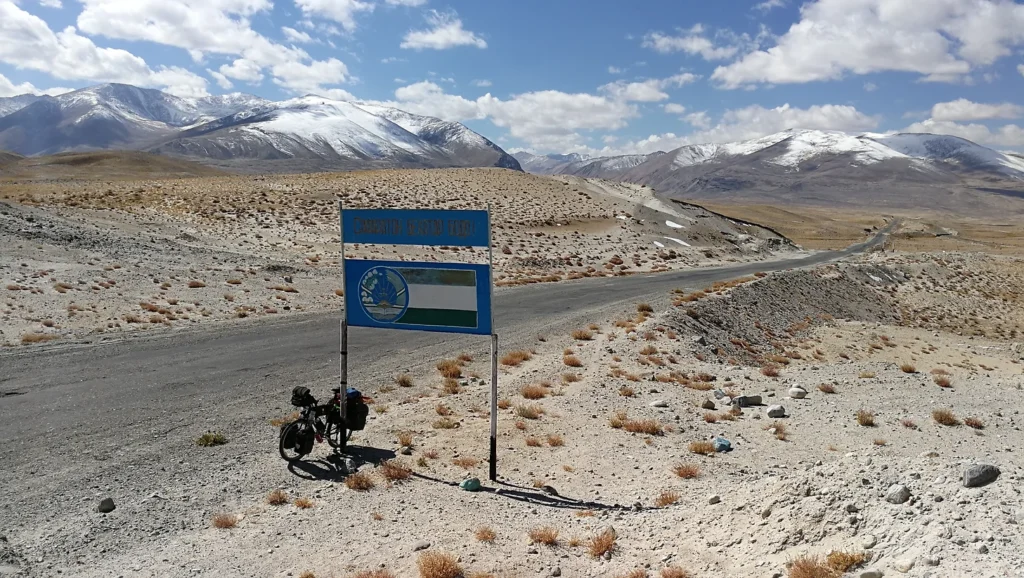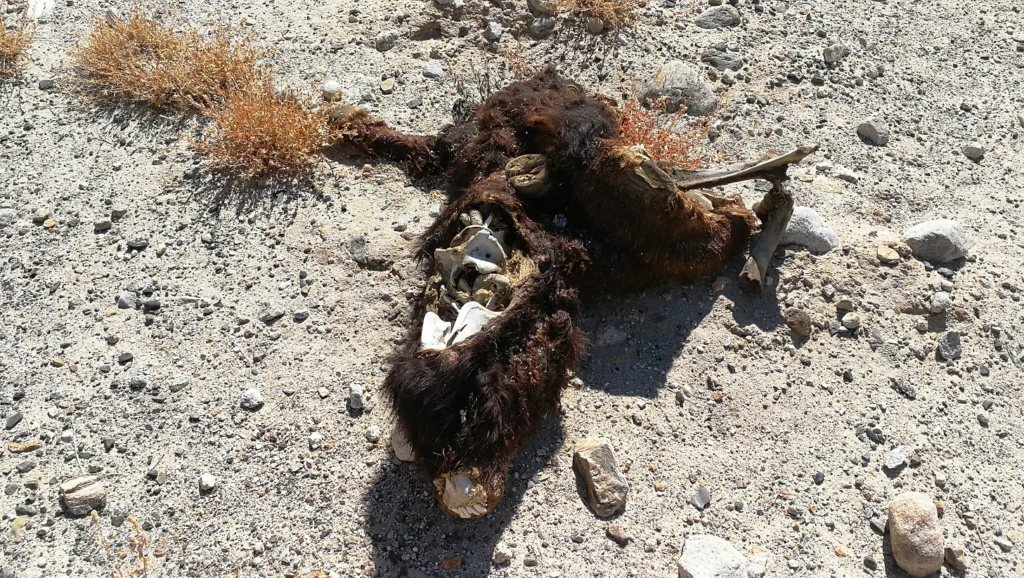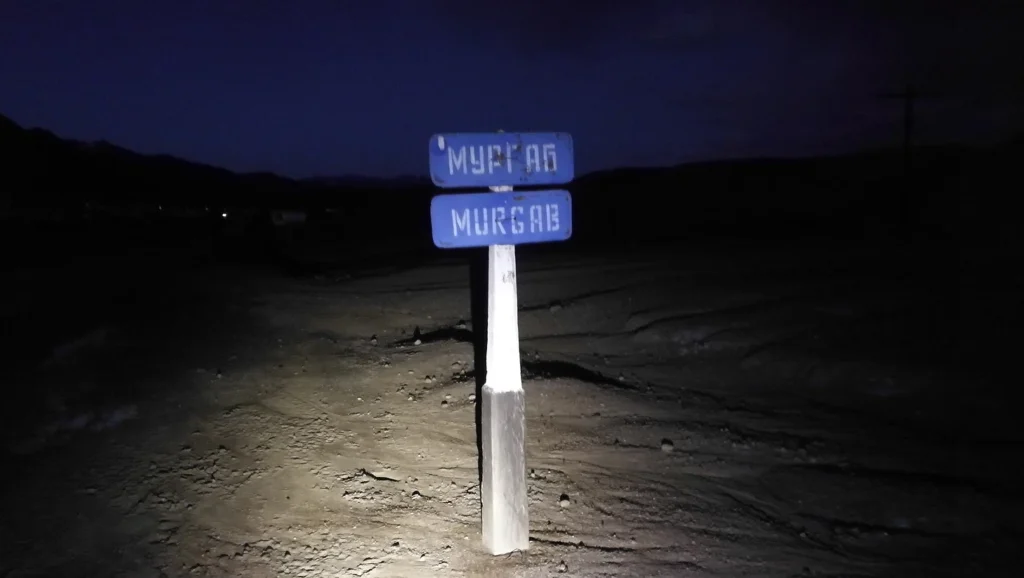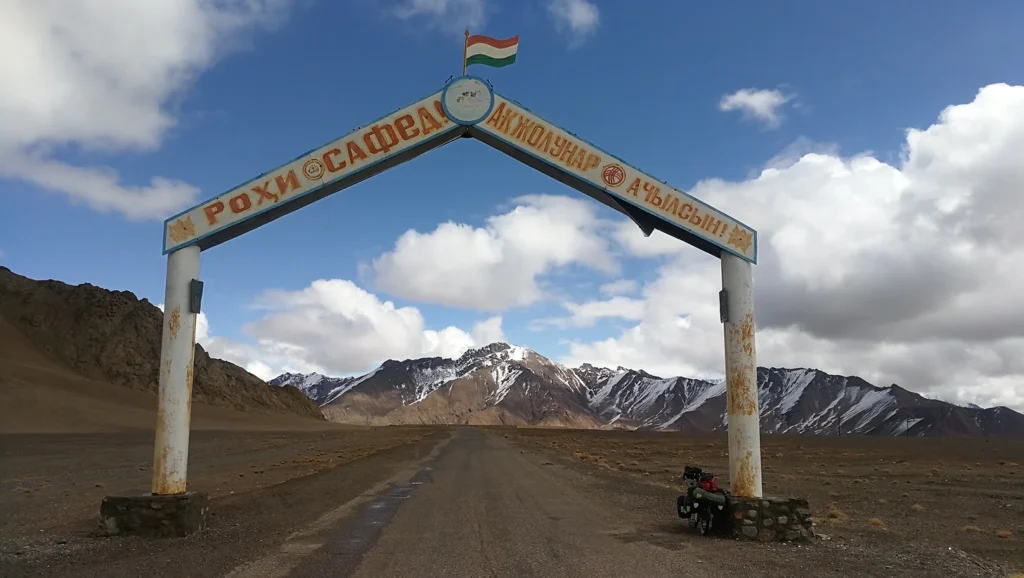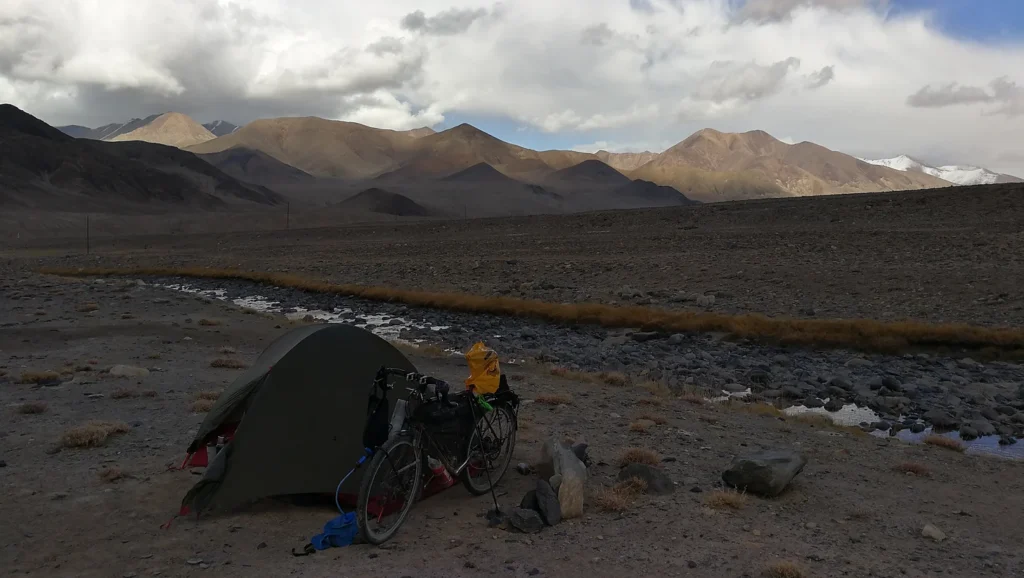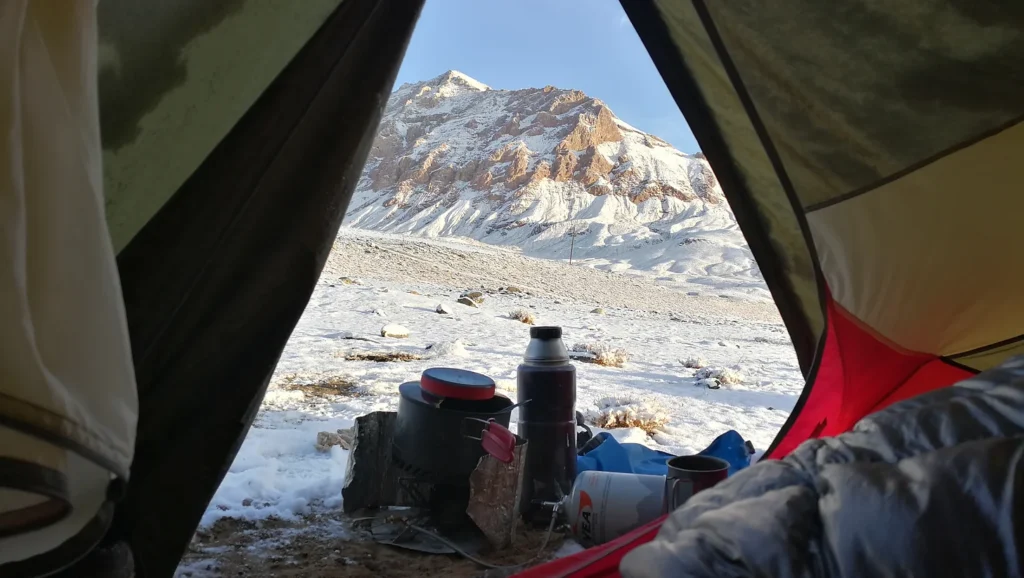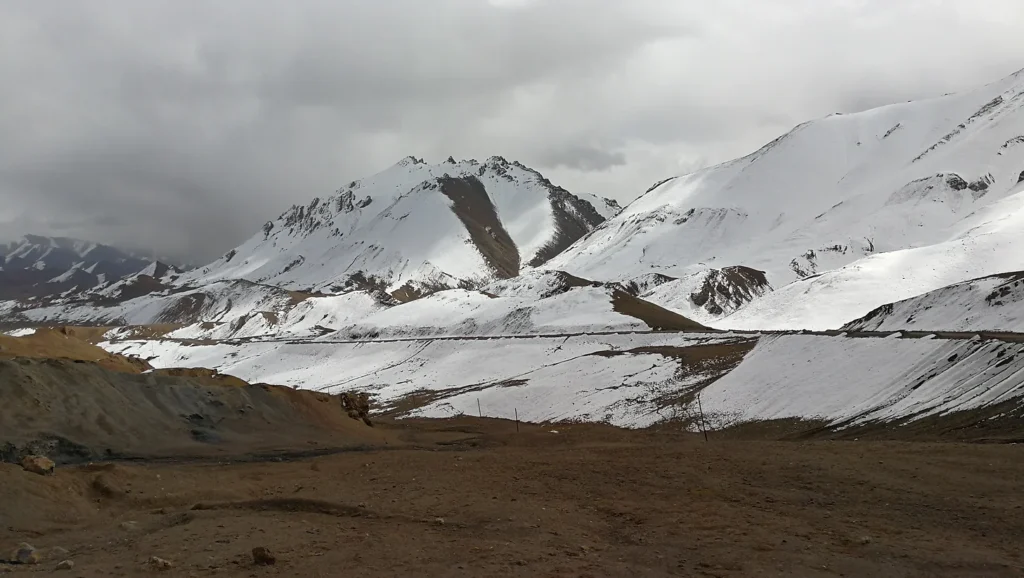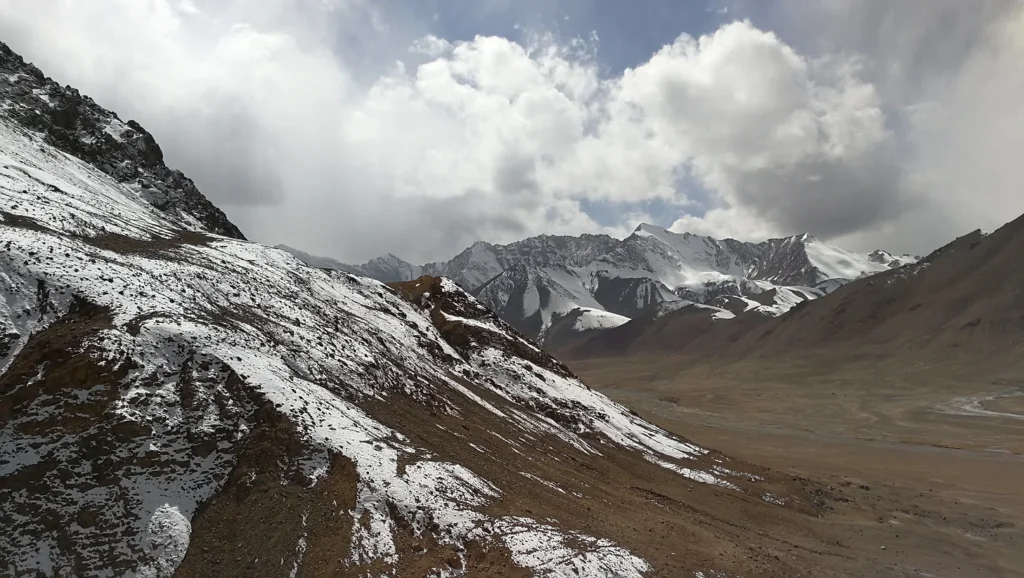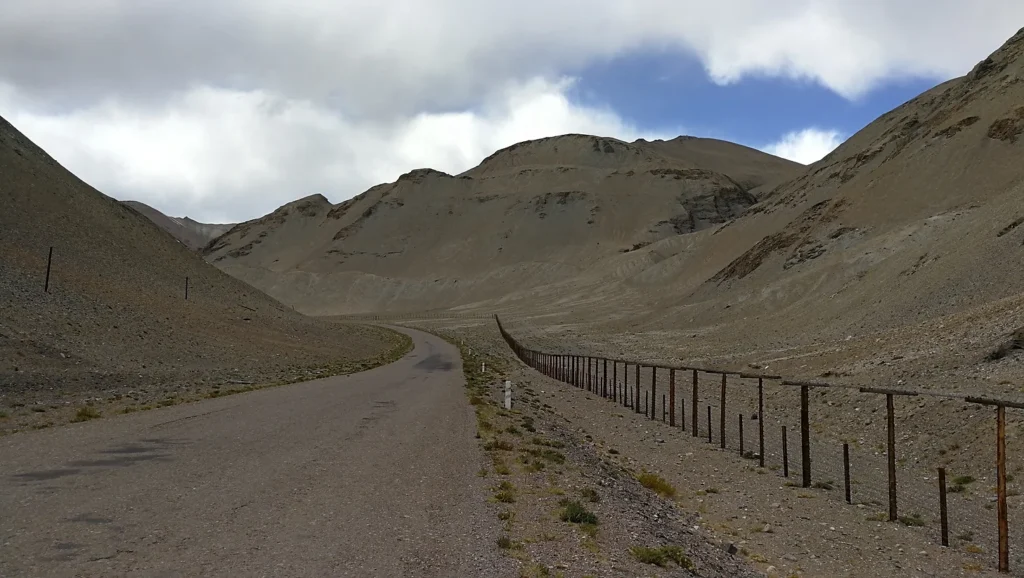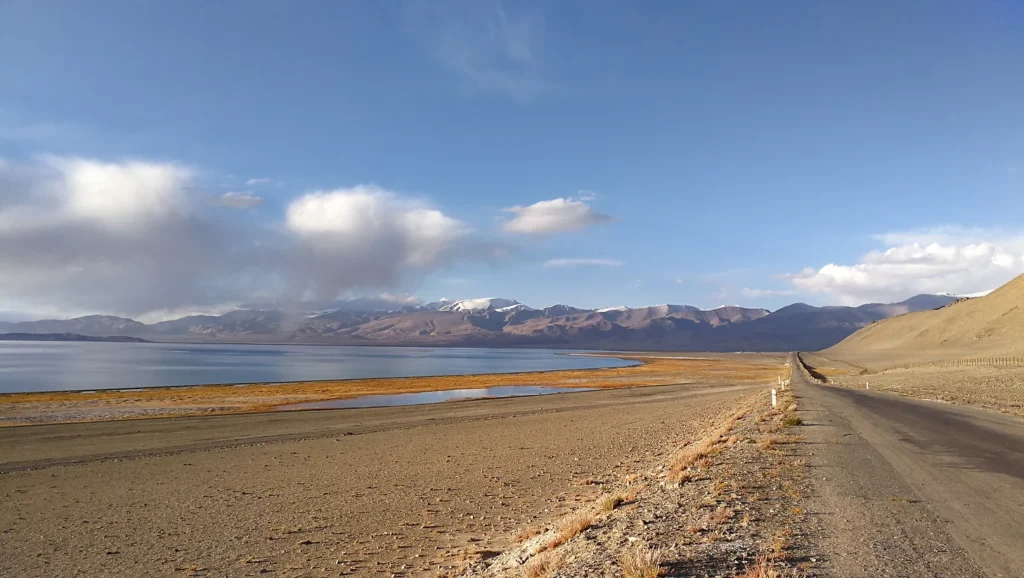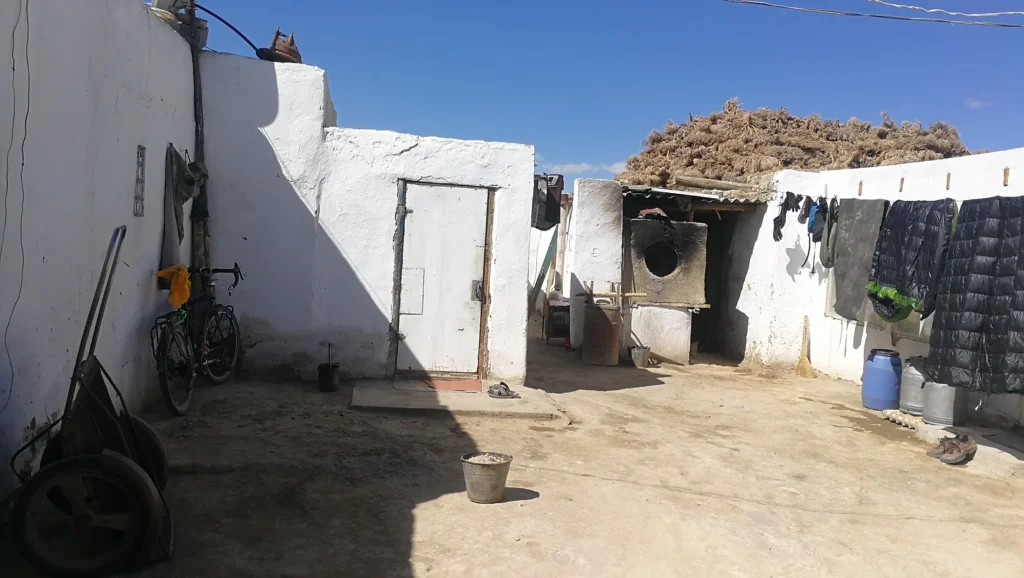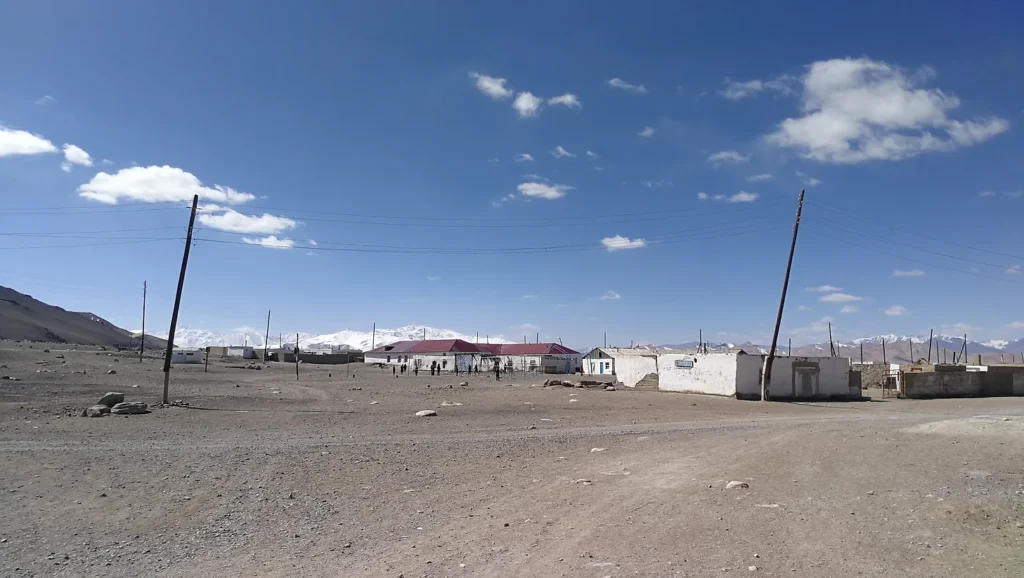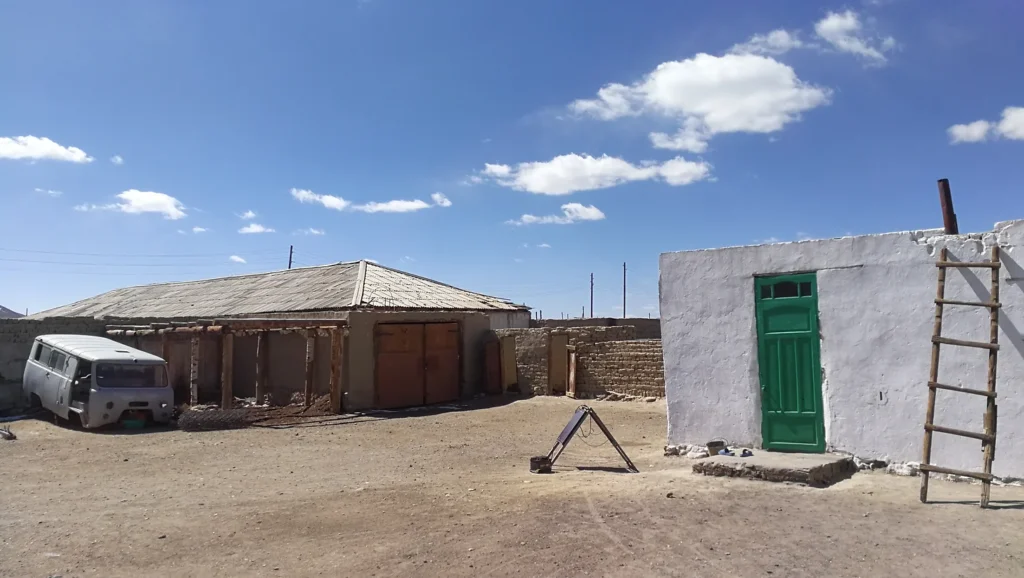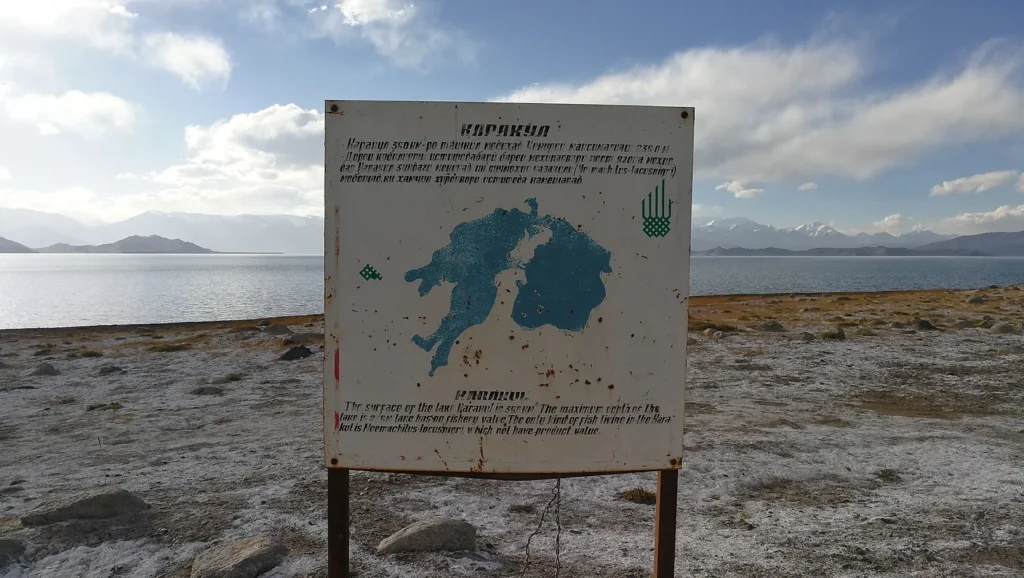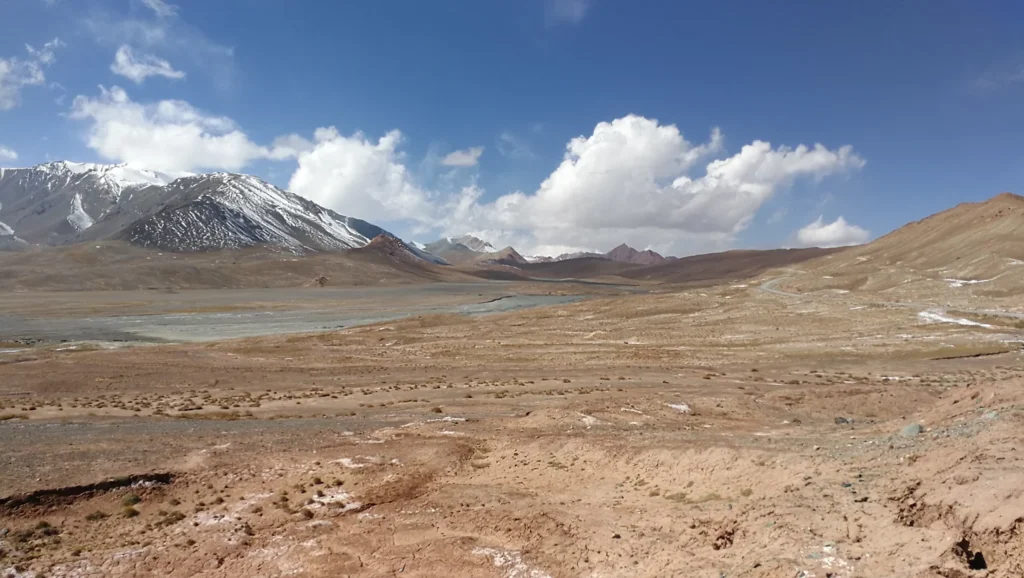Tajikistan — Growth
We cycled together to the border, crossed it in one hour, and then split up as I wanted to cycle slow. Nobody else crossed the border while we were there – from Afghanistan there is probably not much traffic coming up, and most travellers from the north take the M34 into Dushanbe.
The border town is home to TALCO – one of the world’s largest aluminium manufacturing plants. It’s Tajikistan’s most important company.
The town Tursunzoda (“Турсунзода”) is named after the Soviet era poet and politician Mirzo Tursunzoda who is shown on the 1 Somoni banknote.
60 kilometer after the border I reached the gate of Dushanbe – this country made a relaxed first impression and I felt good.
How do you feel right now?
Breathe in, breathe out. Breathe in, breathe out. Your biological body is existing just fine.
You are free to create any consciousness journey you want. You always have choices how you want to live the next moment and how you choose results in the life you create.
You are existentially free in your consciousness to give attention to any object you want – like giving attention to your emotions. And you are existentially free to give any kind of attention that feels right – like giving attention with compassion and acceptance and an openness to learn, develop and grow.
Freedom means responsibility – only you can create the consciousness journey you want. Don’t wait all your life to begin, and don’t wait for others to give you permission. If you want to use your reality-bending force more consciously, feel inside yourself and practice self-leadership.
Starting is uncomplicated. For example, give your emotions compassion and acceptance for two breaths – breathing in, breathing out, breathing in, breathing out. Congratulations, you have just changed your reality.
And if you can do it now you can do it again – nobody exists who would stop you and with repetition your reality-bending force gets larger.
Do you want to grow your ability to use your force more consciously?
You can, if you choose so.
I stayed three nights in Green House Hostel – a reliable base for travellers heading into or coming out of the Pamir mountains and a great place to exchange stories from the road.
When your bike tour is long, replacing tires becomes relevant. However, as a bike mechanic in Istanbul had pointed out: “Buying spare parts in Central Asia? Forget it!“.
Sure you can try to have spare parts send into the tour. But will that be possible in the region you may need them? The rough gravel in the Pamir mountains will wear down tires multiple times faster than tarmac and the stones of the Pamir roads may also cut a tire (perhaps fixable with glue and a sewing kit). Some touring cyclists bring two spare tires but they are bulky and heavy – so my strategy was to buy just one spare folding tire in Tehran.
What’s the best way to use a single spare tire?
Cyclists get stuck when one of their two mounted tires falls apart while they have no more spare tire. In my view, the best strategy to use a spare tire is therefore to have both mounted tires being used up completely at the same point in time – after already having used the spare tire completely.
The back tire is used up faster than the front tire in all bike setups due to the higher weight on the back tire (rider). With my bike setup, I noticed a profile decline 1.5x faster on the back vs. the front tire.
After mounting two new tires in Istanbul, I therefore cycled with them until the back tire was worn down 80% and the front tire 53%. That moment was now and I replaced the back tire with the fresh tire from Tehran – later when the front tire is worn down, I’ll mount the used back tire to the front and like that all tires will be used up completely.
I bought food for one week – enough to cycle 320 km southeast via Kulob to the border with Afghanistan and then 360 km along the border river Panj until Khorog.
Dushanbe is Tajikistan’s largest city and has been the capital since the country gained independence from the Soviet Union in 1991. The downtown area has a pleasant mix of tradition and modernity and is fun to cycle around.
The city doubled in size over the last 40 years and feels vibrant, growing, and full of life.
With 165 meter the flagpole in the city center used to be the world tallest free-standing flagpole but has meanwhile dropped to place three.
I cycled out of Dushanbe feeling excited – after weeks of mostly desert cycling now weeks of mostly mountain cycling lay ahead.
After not having checked the road’s elevation profile in detail I was pleasantly surprised about the size of the mountains here – and given the combination of intense heat and uphill I ran out of water.
The beauty of Nurek reservoir touched me – the water reflected mountains kilometers away in detail. This reservoir was created by the second tallest dam in the world which is Nurek dam with a height of 300 meter.
After a second long tunnel made for carbon-monoxide-lovers, the land opened up and I rolled mostly downhill for the rest of the afternoon.
I got water in Dangara, birthplace of Emomali Rahmon who is Tajikistan’s President since 1994. Before becoming president, Emomali was Dangara’s leader when it was a collective farm (kolkhoz) and later state farm (sovkhoz).
I pitched camp several hundred meters away from the road – I felt like being alone in nature.
Forget about words – breathe.
If you had a simplified choice between being a “shallow-breathing life philosopher” who has it all figured out cognitively, and a “deep, natural and unrestricted breather” whose heart is full of true love for the world and the own life – how would you choose?
Of course we can’t permanently stop our thinking and life is about balance – but balance does not mean neglecting our own biological body and breathing. Balance does not mean being a thinking machine only. Balanced does not mean being dominated by thinking.
From an evolutionary perspective, our feelings and breathing developed long before we developed self-domesticating societal structures and a cult around cognitive “education”.
Sometimes I think connecting to mother nature with our feelings teaches us more than all books of the world – depending on where your feeling-cognition calibration stands.
… whatever …
Breathing in, breathing out
A sniffing sound wakes me up. Three stray dogs outside my tent. Cowards – they ran away as soon as I moved to say good morning.
While drinking my morning coffee watching the sunrise, a falcon almost grabbed a little bird in the air in front of me. The falcon’s attack maneuver made a swooshing sound when he aborted the strike in the last second, possibly because he saw me moving.
The exhausted little bird took cover at my bike, sitting on my crankset for some minutes with his heart rate and breathing visibly racing. Close call little bird, you almost got killed and eaten.
Nature, of course, does not discriminate or take subjectively constructed sides. Nature just is, maintaining balance. When the prey population goes up and down, so does the population of predators feeding on it – be it mice and foxes, salmon and bears, or little birds and falcons playing catch and kill in front of my tent.
I watched some ants carrying away a flake spilled from my muesli. In nature nothing goes to waste, nature is a circular system and “waste” is just a subjectively constructed term – the ants would call my muesli flake “resource”.
A dust cloud came down slowly from the mountains. It was a herd of cows navigating towards the water of the creek next to my tent.
So naturally acting out of their direct existence! So naturally being without overthinking, so much balance!
The cows are true Zen masters.
I stopped at a monument on the Dangara region. Perhaps the painting shows cotton fields? Cotton is the dominating crop in this region and Tajikistan’s second most important export good after aluminium.
While I admired the monument, two traffic police gentlemen came by and one asked repeatedly for my sunglasses as a present – I remained friendly and at some point just left.

Near Gulistan I met a cool Swiss touring couple on the road and we stopped and chatted for a while. They had cycled through the Pamir mountains over the last weeks and said from here the road ahead is “good” all the way to Qal’ai Khumb.
What I realized two days later pushing my bike over unrideable rocks was the calibration of their road evaluation perspective. They had just cycled the entire Pamir and managed to bend the steel frame of her bike, a sturdy Santos Travelmaster. They said they wouldn’t cycle the Wakhan valley again and that many people destroy their bikes there – thus relative to those roads, my road ahead was truly “good”.
Isn’t good in life always something relative?
I would say it depends. Yes, we can always compare what we have with something else. But no, we don’t have to do that – this is our free choice in our consciousness.
I believe it’s healthy to first establish thankfulness in our life before we reach for something else that is “better”. It’s great to have goals and things like that – but if we make our life satisfaction dependent on something “better in the future”, some “achieved goal” of any future-oriented type – are we then ever satisfied with what we already have?
I feel that by existing as humans, you and I and all other humans are already fundamentally valuable and lovable biological beings – no goal-achievement required.
I gave the Swiss couple my Uzbek SIM card that I myself had gotten from a touring cyclist coming towards me in Iran – nature is a circular system and “waste” just a subjectively constructed term. In the end we are all just visitors on earth anyways.
North of Kulob a car drove next to me and the driver gesticulated wildly. First I ignored him assuming that he meant I should cycle more on the side of the road and in my view I was already enough on the side.
But then I stopped and it turned out that the driver just wanted my best. He assumed that I wanted to cycle to the Panj river and that I had missed my turn – he was right, I thanked him and turned around, cycling 20km extra today but thanks to this gentleman not more. I made a mental note to always give people an opportunity and listen first before judging.
After returning to the right road I cycled uphill for hours in 37°C / 99°F … 1,400 meter elevation gain are a lot when you start in the late afternoon.
The road was unpaved for the last two hours before the pass and I had to push my bike for a while – just like yesterday I ran out of water.

It was simple: I had to keep going over the pass to get water.
It got pitch black soon after sunset and surprisingly also cold so I rode in my jacket for the first time since Armenia. Perhaps I was cold from exhaustion. After the pass I pushed my bike on a flat stretch where the road was still unrideable when I suddenly heard loud voices in the dark – I had reached an unlit military checkpoint.
Quick visa registration, friendly soldiers. Shortly afterwards I reached a police checkpoint – at this particular pass I can understand that they operate double.
I reached a small town with a small shop still open and finally got water. Some drunk locals chatted with me at the shop, relaxed atmosphere.
Today had been the new longest and toughest day of my tour but I felt fantastic and started the downhill into the dark feeling free.
At sunrise I realized a reward from having pushed forward over the pass last night: first views into Afghanistan.
This is the place where the Hindu Kush and the Pamir mountain ranges meet.
I decided to half my pace over the next couple of days to fully enjoy the experience of cycling here. This was a region I was very excited to be in and I wanted to take the time to arrive in the place where I already was – I wanted to really feel it.
I cleaned my drivetrain and calibrated my brakes until noon, going slow, letting the work flow out of my hands in a natural pace while enjoying my surroundings.
I then cycled down to the river Panj. Where the mountains here more colorful than normal or did I look at them with rose-colored glasses as my mountaineer heart was super happy?
This stretch of the Pamir highway has just been upgraded with perfect tarmac but there was zero traffic. The people living here are poor – electricity and running water are rare. But how rich they are in beauty of nature and simplicity of life!
Hopelessly romantic? Maybe, but is the consumption society in “rich” countries really desirable? I don’t know
How much snow do you think they get here in winter? Is this riverbed a torrential stream in spring due to meltwater?
In Kisht I asked around for a shop – it’s “magazin” in Russian. Locals pointed me to a place behind a mud wall which was the town’s only shop, consisting of a room in the house of a family.
They sold basic food and household items like rice and candles but no bottled water –Tajikistan’s poverty rate outside Dushanbe is similar to Afghanistan and I realized bottled water wouldn’t have buyers here.
The vastness of the land, the dimensions of the mountains and rivers – it’s all enormous here. How many unnamed and unclimbed peaks and ridges must exist in this region?
I find the thought fantastic that there are wild places left on earth which are unexplored – not from the perspective of an explorer how wants to “be the first”, but quite the opposite: I find it fantastic that there are unexplored places where mother nature has been left in peace, and I hope that many unexplored places in nature will remain so forever.
And Afghanistan on the right side of the river? How rich must that country be in wild and unexplored places!
In most parts of the Panj river valley Afghanistan is so close you could throw a stone over. I’m sure there are many wild and unexplored places in Afghanistan … but perhaps the really wild and unexplored places are inside our heart.
Here Tajikistan borders Afghanistan’s Badakhshan province which also shares borders with China and Pakistan. Where I was right now the mountains were 4,000 meter tall but 200 km southeast in this province they rise up to 7,500 meter.
How do you think the people in the Afghan villages across the river live?
I would like to understand the history and culture of this region better – I’m sure there are many different ethnic groups, tribes, and communities within Afghanistan with many different sub-cultures and traditions.
Tajikistan’s Darvoz district said welcome with a sign. It’s the beginning of the Gorno-Badakhshan autonomous region which makes up 45% of Tajikistan’s territory while only 3% of the country’s population live here.
On the Afghan side a police patrol drove by on the road next to the river. Three pickups, each with two men in the front and one in the back standing behind a mounted machine gun.
I felt respect for the Afghan policemen – it takes courage to do their dangerous job while earning 200 USD per month.
In 2017, on average 28 Afghan police officers and army members got killed – each day of the year.
For the first time since reaching the Panj river the road rose up high over the valley. On the Afghan side a steep zig-zag path showed that people regularly walk from the river over the mountain – the people living here must be strong.
How is your inner zig-zag path over the mountain?
I’m sure you also have one you walk regularly in your life, we all do – just the shape and color of our personal zig-zag paths differ a little bit on the surface.
Perhaps more relevant is the question how you handle it, your attitude towards the zig-zag path, your openness to learn from it, your sensitivity to feel it.
I’m sure it has already made you strong, dear reader – and I think it will make you stronger every day of your life.
I feel that we all have a lot to be thankful for every day of our life. When we have running water and electricity, basic healthcare, and functioning roads – we have much more than a large part of the world population.
Settlements, roads, civilizations, your and my biological life – everything is ultimately washed away by the big wave of time.
Do you see a deeper meaning in that?
Our life, our whole reality seems to be composed of different forms of light and shadow – can we perhaps use our reality-bending force to shape both?
In a valley with a steep wall on the left and a river on the right, good campspots are rare. An area with vegetation initially looked promising but then the landmine warning sign turned me off and I cycled on.
Just before sunset I found a great campspot with good views across the river. A motorcycle with two Afghan men appeared and they stopped right on the other side. Had they seen me? Did they want something from me?
No – one man took about 30 selfies at the river while the other man did toilet business behind a rock. We are all humans, on any side of the big river of life.
Light and shadow – how can we navigate them with something like a healthy balance?
We can practice things that at first glance appear “passive” – such as being thankful for what we have in life. We can practice things that at first glance appear “active” – such as setting goals and working towards achieving them.
On a deeper level in our consciousness such a simplified dichotomy probably doesn’t apply – being thankful can have very active elements, and setting goals and working towards them can have very passive elements. But for the sake of simplification, let’s assume for a moment that there are passive and active things we can practice and that finding balance between the two is healthy.
So if there are passive things like “letting arise” and “letting unfold” and active things like “taking control” and “planning and doing” – how do we find the right balance between them?
I would say by listening into our consciousness and by sensing what feels overall good.
In our consciousness we can feel into things like self-trust and thankfulness, coming home to our authentic self, and acceptance and love. And we can feel into things like being achievers, having a growth mindset, and becoming a better version of ourself.
Our life is so multilayered and deep that I believe we all constantly practice many passive and active things in parallel in our consciousness – just like we constantly feel and physically exist as an existential aspect of our life.
The reality-bending force we all have inside, our freedom and responsibility to co-create our consciousness journey through our chosen attention – it somehow seems to connect us all.
When we find balance between passive and active interactions with our reality, and we also develop our sensitivity to feel into other humans, perhaps then navigating all light and shadow in our life becomes really easy … when our being and doing begin to directly flow out of our feelings.
Breathing in, breathing out.
The second law of thermodynamics states that things fall apart – and my first law states that I do something about it.
Hah entropy, you really think you impress me by making the sealing ring of my fuel bottle break? Take that!
Hah entropy, you really think you impress me by making the lid of my cooking pot break? I told you this in the past and I tell you this again – I can glue my cooking pot lid all day long!

Chaos and order, destruction and rebuilding – is finding true balance about calibrating those forces inside ourself?
Perhaps there is really a place where we all come from, a place where we all go. Perhaps our individual consciousness experiences over our lifetime are like rivers branching out temporarily, before being united again in the future.
If that’s the case, the whole chaos and destruction and universal suffering thing isn’t more than a second-class smoke screen trying to put on a scary show that we can unmask with our attention – when we choose to look beyond.
Who knows, perhaps there is no spiritual world and all that exists is physics and after our death we just decompose. But also in that scenario – why should we ever be afraid?
Force-awareness grows self-confidence in us either way.
Is it normal that the trees here stand in the river stream? How have they managed to grow here when they were little trees confronted by the river forces?
And what about stones being washed against the tree trunks – isn’t that a pretty strong force of abrasion scraping away the bark?
Perhaps the meltwater level from the glaciers is historically high due to unusually high temperatures – perhaps mother nature also sometimes struggles with balance, just like us.
Or the trees are just strong and they take the river forces with a smile.

Trees, rivers, thermodynamics … I know almost nothing about the world and the few things I know are uncertain. Feels ok for me – cognitive knowledge is overrated relative to deep things.
If the current river water level in late summer is the meltwater peak, how does the winter water volume look like? Perhaps in winter you can just walk over to Afghanistan.
It’s funny how inaccurate maps can be. My offline maps sometimes showed settlements which didn’t exist in reality, and sometimes they didn’t show settlements which existed – like Jak.
The map-reality gap seems to be usually biased towards not showing things that really exist – perhaps because reality has changed since the map creation and the maps are simply outdated? Perhaps because the map creator didn’t have more detailed information when creating the map? Or perhaps because the map creator chose not to include finer details to keep the map clear?
Of course it’s a desirable characteristic of any map to condense reality which means “excluding information” is a feature of a good map, and not a bug – a map including all details of reality would be reality itself.
The semantics researcher Alfred Korzybski noted:
“A map is not the territory it represents, but, if correct, it has similar structure to the territory, which accounts for its usefulness. (…) If we reflect upon our languages, we find that at best they must be considered only as maps. A word is not the object it represents”
What about the mental maps we use to navigate our reality?
Perhaps thinking in map zoom levels rather than judging a map based on the contained details is the best usage of maps. If we want to draw a useful map of the universe we would probably indicate the whole planet earth just as a dot.
Can we calibrate our consciousness attention to different zoom levels? What happens when we zoom out?
If our internal reality navigation was just as easy as our external life where a leader may tell us that the sun shines and that unity, peace, and stability are our values!
In Yoged, another very real town which wasn’t shown on my map, a met a group of boys who demanded that I take a picture with them. They spoke pretty good English and explained that their new school year had just started on 1st September.
The last 30 km before Qal’ai Kkumb the tarmac disappeared and I pushed my bike some stretches. When the road consists of freshly broken stones (sharp edges) I would estimate the tire profile is worn down 10x as fast compared to smooth tarmac.
On this stretch I met a bike tourer coming towards me, a tough guy with much bike touring experience. He was worried his tire may rip apart after getting an impressively big side cut from a stone (same tire model I ride). Still he emphasized that the Wakhan valley is “rough but definitely doable“.
I have always felt respect for people living in the mountains – life in mountain regions has something honest, something focused on the essentials, a clarity that only emerges in a harsh physical conditions.
In Qal’ai Kkumb a sign of the Swiss Foundation for Demining Afghanistan brought my romantic mountain life thoughts back to reality.
More than 1 million small anti-personal mines dropped by Soviet helicopters in the 1980s are believed to remain in Afghanistan’s soil – in addition to unexploded ammunition of various kinds added during the always ongoing armed conflicts since then.
Afghanistan’s Darwaz district on the other side of the river, the northernmost end of the country, can’t be reached by roads from the south – in summer people can walk 2-4 days over the mountains while the rest of the year the region is isolated due to snow. Near Qal’ai Kkumb, a bridge allows access to the Darwaz district from Tajikistan.
Do you think there will ever be an end to war?
We could look back at the historic track record of humanity and be pessimistic. The cultural critic George Santayana observed soldiers celebrating the end of World War I, and reflected:
“They are hardly out of the fog of war when they are lost in the fog of peace. If experience could teach mankind anything, how different our morals and our politics would be, how clear, how tolerant, how steady!
If we knew ourselves, our conduct at all times would be absolutely decided and consistent; and a pervasive sense of vanity and humour would disinfect all our passions, if we knew the world.
As it is, we live experimentally, moodily, in the dark; each generation breaks its egg-shell with the same haste and assurance as the last, pecks at the same indigestible pebbles, dreams the same dreams, or others just as absurd, and if it hears anything of what former men have learned by experience, it corrects their maxims by its first impressions, and rushes down any untrodden path which it finds alluring, to die in its own way, or become wise too late and to no purpose (…).
They think that the war – perhaps the last of all wars – is over! Only the dead are safe; only the dead have seen the end of war.”
Is such pessimism justified given our reality-bending force?
Why should we not succeed in “knowing ourselves” sufficiently to become wise during our lifetime and maintain peace? Why should we stay “lost in the fog” when we can practice self-reflection?
Instead of looking at humanity’s historic track record and pessimistically extrapolate from past wars that they will repeat – we can change our perspective and look inside ourself.
Close your eyes and place your hands over your heart space. Feel yourself, feel into your consciousness. This place is yours, this is where you co-create reality.
No, this is not a utopian dream – your force is real.
And when we simply practice a bit of self-reflection, when we feel what our consciousness truly holds, there can be peace – I believe in the core of every human is a natural force for the good.
Do you think your life is small and insignificant? Do you think there are somehow “larger forces out there” preventing you from co‑creating a world you truly like?
You have the force already inside yourself. Wherever you are and whatever you do, you can feel it inside your consciousness – and you can let it grow through your chosen attention.
And as a consequence, the cycle of “each generation creates war” can be broken by you and me. We can see the end of war inside ourselves and thereby create the end of war outside – no need to wait until we are dead.
You might say “Sounds dreamy – but fighting is part of life!”. You might say “Sounds romantic – but it’s just not true that the core of our consciousness is peaceful!”
I’m just a cyclist and I have no idea what the consciousness of other people holds – I don’t even know what my own consciousness holds, but I’m working on it.
And in no way shall the argument made here be prescriptive – the true core of every human is what it is, not what we like it to be.
But I do believe a couple of things which make me optimistic.
What we think to be true becomes true in many ways – we constantly choose our consciousness attention regarding it’s direction and underlying emotional flavor, and how we choose is reality-bending. We all have the power to change our journey – we are powerful as individuals.
And here is an additional thing with our consciousness. The mental maps we use to navigate our reality can be adapted. Yes we could have a long discussion around “free will” and the ultimate nature of reality and everything like that – whether it’s an illusion or not, we seem to be pretty free creators of our world concepts and the mental maps we use to navigate life.
So when we choose so, we can give more attention to our human community – we can give more attention to others. And if that’s our adapted mental map, if that’s what feels right, we begin to base our decisions and actions on an integrated view of what’s good for us and for others in combination.
With such an expanded mental map, I believe the chance that we choose war diminishes greatly. I don’t believe at all that anyone’s life is small and insignificant – we are powerful as a collective.
Do you also sometimes wonder if the universe places impulses on your life path in situations so specific that you doubt that can be coincidence?
I cycled out of Qal’ai Kkumb feeling calm. In the steep river valley it gets dark early but then the twilight stays for two hours, enough light to pitch camp and cook without a headlamp.
I got up early and watched the sunrise. Have you ever observed how fast the sun moves?
All locals I met in Tajikistan were super friendly. If the positive energy and self-confidence of the children here is a predictor for the future, Tajikistan has a very encouraging outlook.
I wonder how people in Tajikistan and Afghanistan think about each other. Sure, there is the perspective of “leaders” – but how do for example traditional farmer families feel for their neighbors across the river?
In the Pamirs cow dung is collected and dried to make fire – it’s smart, resources here are really scarce. I would do the same if I lived here.
Afghans by the river – perhaps they are cleaning a carpet?
After Qal’ai Kkumb some trucks started to appear, probably because from Qal’ai Kkumb there is another road north connecting to Dushanbe.
Cows relaxing by the river. The other river side is the northernmost point of Afghanistan.
I felt respect for the truck drivers on the Pamir highway – this job is not for the fainthearted. The drivers seem cool, almost always they smile and say a friendly hi.
I wonder how much roadside messages influence the consciousness and values of people living in an area. Here many signs address a sense of togetherness or an element of a common identity.
The president is shown a lot on public pictures – this is the first picture I saw showing him together with other people.
The traffic on the Pamir highway basically consists of trucks and sometimes a jeep. The truck with the two excavators made it up the hill on third try.
From Dushanbe to Murgab the Pamir highway is basically an uphill for 1,000 kilometer – I liked this stretch from the beginning.
Excuse me, what time is the bus leaving?
Sometimes Afghanistan is greener, sometimes Tajikistan. Sometimes the road on the Afghan side is higher, sometimes the road in Tajikistan.
Is there another border region in the world where along 1400 km people can watch each other closely across a border? Perhaps yes … I don’t know.
Given that there was no pass or settlement nearby, I would assume this bulldozer is neither for snow nor for construction work but to clear the road from rockfall in this area.

Cycling into the evening I looked for a place to camp with a freshwater source – I had seen zero natural springs on the Pamir highway so far but I stayed optimistic.

Just before dark I found a really great campspot – above the road but not visible from it, flat and spacious terrain to camp, and a little waterfall 200 meter uphill. How good can it get?
Getting water from the waterfall was more difficult than I had assumed. The last part before the waterfall was almost vertical, the return trip took 45 minutes, and given that I got soaked by spray water I descended shivering from cold with slippery sandals – I felt fantastic, I felt free.
Have you ever considered that you really change the world all the time, dear reader?
Whatever you do, wherever you live, you leave a trail behind reflecting your consciousness attention – and your actions. And while you form your life trail, you grow.
In my view our growth happens automatically – it unsurprisingly turns out that through life experiences we usually grow one way or another.
Should we shape our growth? I would say everyone is free and your answer is as valid as mine. In my personal view, self-reflecting on our growth and somewhat striving for balance is probably healthy.
Balance between being active and passive – between letting arise and taking control.
Balance across different dimensions of our existence, including our emotional, physical, and cognitive growth.
Balance between taking care of others and taking care of ourself.
We all grow constantly from birth to death. We cannot “not grow” – with the ever-passing time we constantly co-create our reality through our chosen attention, and we constantly grow along.
And from an existential point of view, I think we all are constantly growing both “the world out there” (the entire universe with everything in it except us), and “ourself” (a breathing mind-body bundle with a beating heart and a name).
Feel your pulse, feel your breathing.
What’s your name?
In the morning the valley became really broad as this was the point were the Vanj and Panj river flow together.
The Vanj river springs 100 km northeast at Independence Peak (6,940 meter), renamed in 2006 from Revolution Peak. I kind of like both but what about renaming it next time into Consciousness Peak?
At an Army checkpoint I showed my passport, then I continued my uphill along the river Panj. Good cycling conditions – since Dushanbe the daytime temperature was pretty constant 30-35°C / 86-95°F.
The river flows through many narrow and wide sections on its path – but it always flows forward.
And we in our consciousness?
One important thing to take extra care of in the Pamir mountains is health – almost everybody gets sick. Already in Uzbekistan, in Dushanbe, on the road: the quota of people telling stories about serious stomach sickness in the Pamirs is very high. Stories of people spending weeks in Khorog hospital with 40°C fever.
Good cycling friends I met in Iran did a Pamir classic: they started fresh from Dushanbe (flown in from Iran as they didn’t get a Turkmenistan visa) – got a stomach sickness here which stayed with them for weeks, then, with a weakened body, they got additional altitude sickness in the eastern Pamirs (which is basically a plateau at 4,000 meter), as a consequence they had to descent westwards again to reduce their elevation, missed their China visa timeslot, Tajik visa ran out – tour aborted, flew home.
With the massive amount of stomach sickness stories, I decided to always wildcamp and bring all my food – homestays, eating local, accepting invitations etc. is definitely nice to learn more about the local culture but staying healthy here is essential.
On this tour stretch I carried a liquid soap spender and washed my hands and equipment frequently. With bottled water being rare, I also applied a strict water handling system.
At camp I filtered my water and then boiled it as my small gravity-based water filter works against bacteria but theoretically not against much smaller viruses (probably a negligible risk in most circumstances). During the day when boiling water is complicated, I used MicroPur tablets for risky water, and then drank it through my water filter with a straw.

Upstream from the Vanj river confluence, the Panj river carries much less water volume – reaching the other side, even with current high meltwater levels, would be easy.
I wondered about the first humans in this region. Some Pamir cave paintings are believed to be up to 10,000 years old.
While I was sitting in the sun admiring the beauty of the valley I suddenly heard explosions nearby. What was going on?
It turned out some Afghans were building a path into the wall, probably to connect the villages along the river without the need to climb over the mountains. They used percussion drills powered by a generator, iron sticks to break of stone chips, and dynamite.
In the evening I found a scenic campspot with a freshwater stream – perfect at first glance. But camping on sand is always dirty and I got bitten by sandflies and lay awake for hours scratching their bites. Once you have been bitten there is not much you can do but put on some spit and endure the situation.
Sand flies, which on this occasion bit me in front of my tent during dinner, are one of the reasons I have stopped sleeping on the ground without a tent. While it feels good to sleep without a tent under the stars – snakes, scorpions, and camel spiders are real and a tent simply keeps them away from your bags and face.
I had just fallen asleep when around midnight someone pointed a torch in my face and yelled “Davai! Davai!” – a group of Tajik border soldiers had almost stumbled into my tent.
They seemed nervous so I shined my headlamp on myself to show them that I was an innocent cyclist. Communication was limited but we soon understood each other. They told me I couldn’t camp here because of the border – apparently it is the military logic that you cannot camp on the river side of the road while on the other side of the road it’s fine.
To make them focus on something positive (a control item we could tick together), I suggested they check my passport and visa. Long check, then accusing looks: No visa!
They expected a traditional visa sticker in the passport and didn’t know about self-printed E-Visa (just introduced last year) but in the end my entry stamp convinced them that all was ok.
The group then briefly consulted and came up with the idea to get money from me: the leader, still shining the torch in my face, grabbed his machine pistol a bit tighter and demanded “20 dollars!“. My answer was no. He tried some more times “dollars! dollars!” but soon realized that he picked the wrong guy.
There are many different ways to say “no”. I chose a tone that was both calm (to avoid shaking up aggression) and assertive (to be clear). After some more confident “no” they simply gave up realizing that I had called their bluff.
We then chatted a bit as if nothing had just happened (“What’s your name? How many kilometers from Berlin? …”) and they seemed genuinely interested in an adventure cyclist. Then suddenly all was good to camp here and they wished me “dobry noche” (good night) and disappeared into the night.
I felt respect for the guys. They probably earn very little doing a dangerous job to make their country and the world beyond safer – night after night. No hard feelings and all the best gentlemen!
I slept long and started late – no need to rush in the morning because of midnight adventures.
Just when I ran out of water around noon I passed a shop selling water – cool.
When mountain valleys open up I always find it lifts up the mind too – perhaps there is a similar effect regarding valleys in our consciousness?
I read that the people in Rushon district take pride in their friendliness and the locals here are indeed extra friendly. Warm smiles everywhere, enthusiastic kids running up to road to give high fives – the people here cultivate a positive energy they to be proud of.
Nice to meet you too. You guys rock!

Rushon village has 6,500 inhabitants – one of the largest settlements along the Pamir highway.
I wonder how much snow and rain they get here in fall. The mountain wall to the right of the road rises from 2,000 to 5,000 meter elevation and probably channels rain clouds … in this narrow valley the mudslide risk is clear.
Just a couple of kilometers apart, the river water level changed a lot. Near Rushon you could just wade through the river to reach Afghanistan.
But just some kilometers upstream the river filled the valley. Is it normal that the powerline poles are in the water?
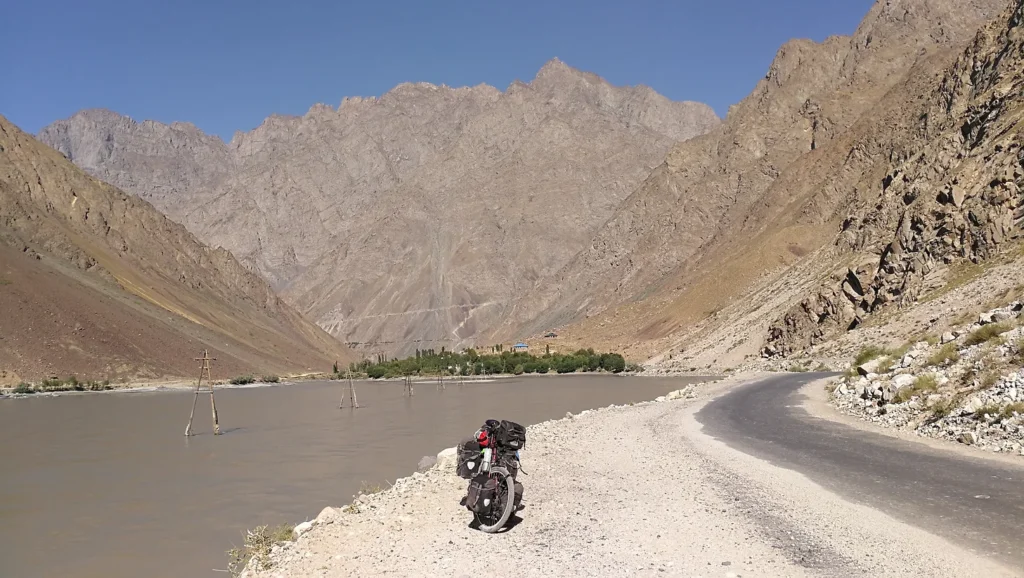
It would be nice to live in one of those villages for some time to learn about the local culture and explore the surrounding mountains – there must be endless hiking opportunities.
Another landmine warning sign on the roadside. Did the people who decided to put the mines here feel into their consciousness? Did they really feel it was the right thing to deploy those mines in the grand scheme of things?
In this valley part, Afghanistan had a dense forest at the bottom of a 5,000 meter peak.
I found an elevated campspot with great views over an Afghan village. When it got dark some dogs in Afghanistan barked for hours but later they all stopped when in the middle of the night the muezzin called for prayer – his voice flowed through the entire valley.
What is the relationship between growing and healing?
We all get hurt in life and that’s natural, as is our growth reaction that results. Chaos and pain and ultimately death are our consciousness gym – we need such stimuli so our lifelong growth process has fuel, has momentum, has something we can learn from.
Where can we start when we feel lost in the chaos of life?
Outside, by doing simple things that feel right and good for us and others – we can start with the doing without any theory. We all already know what’s good for us by feeling it.
Inside, by paying attention to our ongoing consciousness meditation. Living life from the heart, treating ourself like a loved friend, integrating our emotional biography, making our consciousness meditation a priority, listening more in the dialogue we have with ourself – perhaps such ideas work for you too, but you must find out yourself by trying them out for a while and observing how you feel.
It’s important how you feel – our natural need to be loved and connected to others is central in our existence.
Have you ever considered that other people need you, dear reader?
They have been hurt too by life, they too are struggling with their healing. And depending on how you act, you can lift them up with your force.
Trust yourself – you have everything you need inside.
Trust others – whatever challenge life gives you, you are not alone as we all work out in humanity’s big zeitgeist consciousness gym together.
You already are at the place you need to be to grow and heal. Relax into your individual journey, relax into your co-creation of reality – it’s going to be ok.
The force inside yourself is already there and you already use it.
Specifically regarding healing, the “letting arise” part of our force seems to do the job much more than our “active doing” – we can’t brute-force heal ourself. But we can definitely develop a greater force-awareness by practicing consciousness attention and listening more in the constant inner dialogue with ourself … we can sense how we heal when our cognitive voice shuts up for a moment.
Have you ever tried feeling into the wind?
Learning of the morning: when you cycle on a really long tour, tablets in the medical kit rub on each other damaging their sealing, probably from the constant vibration.
Hah entropy, you really think you can create chaos in my medical kit? I just pack the tablets opening-side against opening-side and I will also put some transparent tape over the opening-side – in fact I will do that proactively for all tablets I carry and not just the water disinfection tablets.
Thanks entropy for the learning stimulus!
Yesterday evening I had picked a campspot a bit uphill to avoid another nighttime encounter with a border patrol unit – when I looked out of my tent last night around midnight, I saw in the moonlight a group of soldiers patrolling silently and without flashlights along the road.
When I packed my tent I realized that I had slept above a graveyard – but in a respectful distance, and last night the dead, the soldiers, and I got all along in harmony.
I wasn’t aware that I had come through the “villages with the name of Mirzojon Shirinjonov” but this sign reflects just how friendly the people here are.
Why do the poorest regions often have the warmest people? Is it because they are rich in things that really matter?
Another landmine warning side by the road. Seriously chaos, do you think the whole violence and war thing would impress me?
It does not impress me. In fact, I’m co-creating a reality without you. And even if the rest of the world would be pro-war I would be against it. I don’t follow society’s trends – I form my own opinions based on what I authentically feel inside my core.
And you know what? I will calmly follow the path of what feels right in my consciousness until the day I die – and that day I will die with a smile, knowing that I have lived true to myself.
Coming to our middle probably doesn’t mean creating a world without chaos and violence and landmines instantly – I don’t know how far we can take things when we combine our individual reality-bending forces to a joint consciousness force … existentially seen, we are already a combined force all the time and the only question is how our consciousness attention is calibrated.
When we find true balance inside ourselves, when we accept the beauty of the mountains and the beauty of the landmines equally – what do we create then?
Perhaps it’s time to find out.
I met a cool bike touring couple and we cooked lunch together over a fire. It’s interesting how everyone has their own touring style and way to enjoy the immense freedom that’s offered by living on the bike – everyone is an adventurer, I’m just a drop in the ocean.
We cycled together into Khorog and went to Pamir Lodge – a reliable based for travelers heading to northeastern Tajikistan.
Pamir Lodge is a place to relax and exchange stories from the road – we may be individual travelers in life but in our needs we are all pretty equal.
The Gorno-Badakhshan Autonomous Oblast (GBAO) region in eastern Tajikistan comprises 45% of the countries territory while only 3% of the inhabitants – Khorog is the only major town.
From Khorog there are three routes towards the east – the northern route continuing on the Pamir Highway (M41), the southern route following the river along the Wakhan valley, and the middle route through the Shakhdara valley.
I decided to cycle the middle route and then perhaps over Matts pass (if this was doable) or perhaps over Kargush pass from the north. In any case, I got a permit for the Zorkul Nature Reserve in Tajikistan’s southeast.
I got food for 7 days – which in retrospect was not enough.
Every shifting and brake cable will rip at some point and I had my back-gear shifting cable rip while running errands on my last day in Khorog. This is theoretically a minor issue for the prepared cycle tourer carrying a spare but it turned out that my bike shop in Berlin had given me a spare back-gear shifting cable that was too short – bar-end shifting cables need to be 20 cm longer than cables for other shifting systems.
No problem – I tied the old and new shifting cables together with a knot that tightens under pressure:
It further turned out that the cable housing before the shifter was damaged so that I couldn’t feed the cable back through it – I tried bending and lubricating it for one hour but probably a stuck wire part of the broken cable clogged it, leaving me only one choice: cutting the cable housing at the clogged section.
This was not ideal given that the cable housing before the shifter does not merely function as a protection, but rather changes the cable pull-direction by 180° to make the back-gear shifter work at all.
No problem – I fixed the cable housing with wood and cable binders:
The next two weeks will be a tour stretch that is particularly remote and high in the mountains – what should go wrong?
Around noon I entered Shakhdara valley at a military checkpoint where I got registered. For this area my offline map didn’t show any roads but navigation here is easy as one basically follows the Shakhdara river.

The lower valley started with paved tarmac and a gentle late summer feel:
In the Pamir mountains separate languages are spoken in different valleys – in the Shakhdara valley I believe the locals speak Shughni.
Near Midenved village the valley is surrounded by particularly steep walls, probably increasing the mudflow risk in times of heavy rain.
The Shakhdara mountain range divides the Shakhdara river valley from the Panj river valley and the Hindu Kush mountains in the south.
It contains at least a handful of 6,000 meter peaks – even those do not seem to be named consistently. I would assume there are countless 5,000 meter peaks in the area which are unnamed and unclimbed.
The first 6,000 meter peak appeared in the south – for people in this region it’s probably not something special as it isn’t that high … but having started cycling in flat Berlin my mountaineer heart got touched.
Twice today I had seen bulls fighting wildly in steep terrain, smashing their heads together like mountain goats – but if you cycle past them calmly they don’t even look at you.
Time to find a camp spot – hard choice given the endless camp opportunities in this valley.
What a day … I felt happy, I felt free.
Do you sometimes feel a longing inside for something you can’t really grasp but you know is there?
Perhaps we all feel it. Perhaps it’s something we all have experienced a long time ago, something we feel at the edge of our consciousness when we start to remember, and then it grows when we give it attention.
How do you express your version of that longing?
It’s already inside yourself, listen. Tune down your cognition as word-based explanations are in the way – feel more.
Do you feel grateful for the beauty of nature?
Do you sometimes feel touched by the infinite number of surprises and learning opportunities our life offers?
Perhaps we grow as humans when we practice feeling into such questions – however we individually answer them.
Yes we can cultivate a cognitive growth mindset. Yes through repetition we can take on life with a positive attitude and we grow stronger by overcoming challenges in our daily life – but growth can also happen deeper.
We cannot control everything. Even though we have a reality-bending force it’s not limitless and we only co-create reality – independent of where you see the other reality-creation part emerging from (physics, spiritual, …). In any case, we probably benefit from finding our sweet spot between control and acceptance.
Do you trust in the biological life system itself? You are part of it.
Perhaps deep inside the main hurdle that’s holding us back from our growth is some kind of fear. I’m not sure what it is, it would be easy to frame it as something existential around dying, but probably it’s not that simple – I don’t know.
We all seem to exist pretty stable with our consciousness. We seem to have many reasons to believe that existentially we can trust life’s stability and that chaos is not suddenly coming around the corner to erase the whole existence of our reality (that one day we die biologically is something different).
Perhaps we can trust life more when we give more consciousness attention to simple observations … the beauty of nature, the pleasant feeling of breathing in and out, things like that.
We all are pioneers, living our unique version of a human life the very first time – emotionally, biologically, cognitively. And in my view you can be proud to be a human doing so much consciousness pioneering every day in your life … it takes a lot.
When was the last time you felt gratitude for the beauty of nature?
Your biological body is part of nature too.
There must be many secrets waiting to be discovered in the side valleys – just like in our consciousness.
The tarmac had become bike-shaking gravel and I noticed too late a leak in one of my gasoline bottles – two days worth of cooking gasoline lost:
Near the village Seydzh the valley widened and some grain fields appeared – farmed at 3,000 meter elevation by hand.
In this valley a clear pattern emerged: traditional cows at the lower end, cow-yak hybrids in the middle, and pure yaks high up.
The few farmers I saw waved friendly from the distance. I wish I had spent time with some of them, learning about their lives and their perspective on the world.
Perhaps “the good” crystalizes around challenges. Perhaps people living high up in the mountains always have so much “good” inside because their life is physically hard.
If water can cut through mountains – can your chosen consciousness attention do the same?
Seriously, can it?
Why do you think people live here high up in the mountains – out of tradition?
And you, why do you live where you are living right now?
A herd of bulls – surprising that the meager ground of this valley provides enough food for them. But then again nature is often much stronger than we think.
This valley always looked like its top was just around the corner but the road kept going up higher and higher.
After passing an intersection with a side-river, the Shakhdara river water volume fell by half. Both of those rivers are fed from glaciers in the north and east of this valley.
I pitched camp at 3,200 meter elevation and could feel the altitude – time to meditate on the beauty of nature while cooking a large pot of noodles
Isn’t cycling up a valley like life?
We never know what’s around the corner, step-by-step we constantly make progress, and sometimes we stop and just admire the beauty of it all.
Balanced growth – how do we achieve it in a life full of surprises?
Look at water cutting deep valleys through mountains – flowing constantly gives water this strength.
Look at people growing grain fields at 3,000 meter elevation by hand – they had to keep going after many initial failures to master the technique.
Look at yourself, dear reader – you had to keep growing and learning since the day you were born to become the magnificent human you are today.
All plans and good intentions and growth mindsets of the world don’t have a lasting effect if you don’t stick with things – repeat what feels truly right for you day by day.
The power of force-usage is in repetition.
At breakfast two gentlemen came by to say hi:
In such situations I don’t ask for pictures as I find the human connection more important … I feel more authentic and enjoy those moments more without technology. As a consequence, many human encounters on my tour are documented only in my heart.
However, sometimes people suggest themselves to take a picture, or they ask to take a selfie with their phone and then I ask if I can take one too. Also these two gentlemen encouraged me themselves to take a picture before we said goodbye – and brought the donkey in position who had sticked his head almost in my tent before.
They also gave me self-made cheese and bread which was a welcome breakfast upgrade:

I packed up camp but started to feel increasingly nauseous from the altitude so I relaxed for some hours and started cycling slowly at noon.
In the afternoon the trees disappeared and the valley broadened into a large plateau.
I pitched camp with views on peak Marx and peak Engels (6,700/6,500 meter) – named after two German philosophers who published one of the first communism theories.
For dinner I cooked noodles and mixed them with the cheese I got in the morning – the creamy and hard version had an identical and quite intensive taste.
Balanced growth – it builds on honesty with ourself.
We don’t have to impress anyone and we don’t have to fear anyone – our internal consciousness processes are only seen and felt by us.
Which challenges has your life given you to grow? Are you aware of emotional blockades you are pushing away?
Build honestly on who you are today – perfectly normal with any challenging feelings you may have.
Fear, anger, confusion, hatred, or pain – whatever individual emotional blockades you are working on, consider the effects when you say “yes” and lean towards acceptance and integration.
Such feelings are in all of us sometimes, the only question is their mix and timing in our life. And as having emotional blockades is normal, you don’t “risk” being different by taking an honest look inside yourself – but you have everything to gain.
There are external factors you can be honest about too. Perhaps wars, terrorism, and violence scare you. Perhaps inequality, lack of healthcare, and starving people make you angry. Or perhaps the social media information overload leaves you feeling confused about what’s true at all.
It’s your free choice to be honest with yourself regarding those and any other factors in your life – do what feels authentic, do what feels right.
There are coping mechanisms you can also be honest about. The full spectrum of human avoidance and distraction behaviors (instead of facing your emotional truth) could be part of your life – you probably already know it if that’s the case.
When you choose to practice honesty with yourself, your reality-bending force will grow, and your force-awareness too.
Give yourself permission to feel and find out for yourself.
Breathing in, breathing out.
Fourth day in Shakhdara valley. I still felt nauseous from the altitude but decided that today was the day to cycle up high.
In the last settlement of the valley I asked a local about Matts pass (4,450 meter) – he looked at my bike and said it would be very hard. In Khorog the information I got about this pass was limited. On maps it’s indicated as a path/road but I heard that stone fall makes it tricky.
Still some kilometers to decide. Should I go left or right? The outer path doesn’t matter so much anyways when the inner path is the goal.
Close to the intersection I went up a hill to get a better overview. In the direction of Matts pass it looked like snow and I decided to not go there – there is a fine line between taking a solid adventure cycling risk and being stupid.
This meant I wouldn’t connect into the Wakhan valley and the Zorkul Nature Reserve as taking the longer route via Khargush pass from the north would have overstretched my food supplies.
So what? There are many beautiful routes in life and adapting plans to external circumstances is good.
This left the question how to approach the pass in the north connecting to the Pamir Highway. I still felt nauseous from the altitude so I decided to camp today at around 4,000 meter, cycle over the pass tomorrow, and then directly descend a bit (so I don’t sleep so high).
A shepherd and I crossed paths and we chatted. Sometimes it seems to me that it just takes one look into the eyes of people to see deep into their consciousness, to see their values – and in his eyes I saw that he was using his reality-bending force for the good.
We both wrote our names and age in the fresh snow:
Naruz, 18.
I pitched camp at a small plateau – time to cook dinner:
Balanced growth – how is it fueled?
What we answer probably depends on the concepts we have heard, and then it’s a matter of personal taste what we believe to be true.
Do you believe in a concept of atheism? If yes, perhaps your deepest answer is something around being pragmatic and forming your life based on your individual values.
Do you believe in a concept of hell? If yes, perhaps your deepest answer is something around overcoming darkness to transform yourself into liberation.
Do you believe in a concept of universal love? If yes, perhaps your deepest answer is something around following and doing what feels warm in your heart.
Whatever your answer, I respect it – you are free inside yourself.
Perhaps our feelings give the answers that matter. Our heart is beating, we are breathing, and somehow we all spent our lives doing something while we exist – so why not do what feels authentic?
Yesterday evening while I was lying in my sleeping bag I could hear the little creek next to my tent flowing, then it froze and became silent. In the morning it was first silent outside until the ice melted and the creek started singing again.
I was thirsty but my first attempt to filter water failed as the water froze in the tube between the water bags – a problem easily fixed by taking the water filter and tube in my sleeping bag and snoozing another hour.
A herd of yaks came by at breakfast. They are large but move with light and small steps like gazelles when running.
The pass was a plateau at 4,200 meter elevation.
I crossed a small stream fed by the plateau lake. More lighter trips are always better than fewer heavier trips when carrying the bike and equipment.
The downhill offered spectacular views to the east along the Pamir Highway – from here China was just 200 km away.
It always feels a bit ironic to push your bike downhill but riding over too rough terrain can damage the bike fast.
I had brought enough water from the last river so I just pitched camp at a flat spot overlooking the valley.
Since yesterday I had stove issues, both with gasoline and my backup gas cartridge which I bring for mountains – but in the end my new recipe “Yak cheese noodles” came out fine:
Cool day and my altitude acclimatisation was getting better too – I felt free, I felt myself.
Balanced growth – how do we interact with others who also search it?
Everyone makes a similar consciousness journey inside – the details differ but overcoming emotional blockades is a core task for us all. And like you, dear reader, everyone goes through hell and strives towards universal love or something like that, depending on your preferred metaphor for life.
The more we develop an awareness of what’s going on in our consciousness, the more we can use our reality-bending force to achieve what feels right for ourself while helping others achieve what feels right for them. With honesty and compassion instead of aggression and violence, we usually achieve more while staying relaxed.
Listen to your feelings and express them – this will earn you respect.
Have an opinion and express it – your opinion counts.
Just look inside yourself and take action based on what feels right. Life is not a competition and when superficially “achieving something” or “having more” or “beating someone” does not feel truly right inside yourself – it’s not a victory you will be proud of.
Use your reality-bending force responsibly, whatever that means to you.
Life is beautiful on early mornings – but that’s the same in Berlin or anywhere else.
How is life on early mornings where you live, dear reader? What do you usually eat for breakfast?
Yesterday on the downhill I noticed that my back brake required an enormous hand gripping force to provide any braking power so I checked this morning and found a disintegrating brake cable. The friction within the housing was so bad that the cable pushed the fine-tuning brake adjuster apart when braking – which was quickly fixed with a wire and cable binders.
But even with a fixed fine-tuning brake adjuster the main mechanical problem remained: the disintegrated cable created so much friction within the cable housing that the brake’s release spring wasn’t strong enough to pull back the brake cable – which prevented the brake pads from releasing and resulted in permanent brake pad rubbing against the disc rotor.
I carried a spare brake cable but didn’t want replace it in the field as the worst outcome would be another cable housing issue and losing the brake completely – better to cycle to Murgab and do the repair there.
I tried reinforcing the brake’s release spring with a carabiner, rubber bands, and an elastic string – but no solution worked:
I once learned the golden brainstorming rule to separate idea generation from idea evaluation – so ideas which may actually work are not set aside early.
Tying a stone to the release spring so that the stone’s weight pulls it back by gravity? Oiling the cable housing inside to reduce friction? Simply not using the back brake on the uphills and slight downhills and when using it on steeper downhills just accepting brake pad rubbing and stopping frequently to pull the release spring back by hand?
Or did have another item with the material properties of high elasticity and durability? Dura… wait a minute. At first I thought the idea was a joke not lasting 5 minutes but it turned out that the solution worked flawlessly for two days of mountain cycling.

I thought exiting Shakhdara valley required a river crossing as I had heard a story of cyclists struggling here with high meltwater. When I had just stripped to underwear and sandals ready to carry my equipment …
… a dog came running from out of nowhere even though I couldn’t see a shepherd or anyone else. Good dog – he made me discover the bridge 1.5 km downstream.
The Pamir Highway welcomed me back with a long-stretched climb from about 3,800 to 4,300 meter elevation – acclimatization completed, I felt no more altitude issues.
The Pamir Highway build 1930-1940 is still the only connection from Osh in Kyrgyzstan to Dushanbe through the Gorno-Badakhshan Autonomous Province.
I chatted with a gentleman at a snowplow station where he stands ready to clear to road of snow and rocks. He told me his Russian bulldozer was 50 years old but still works fine.

The next 360 km until the border with Kyrgyzstan were basically a high-altitude desert where the Pamir Highway never drops under 3,600 meter.
This pass (4,300 meter) was unnamed – but then again what’s a “pass” anyways if the road goes up and down in long waves?
In this region of the world, I have the impression that passes, just like 5,000 meter peaks, are simply too frequent and small relative to the big mountains nearby so nobody cares to name them.
Some kilometer after the pass I cycled past another snowplow station. Do the people living here have sheep and goats as a side business? And how do they feed them given that nothing really grows up here to sustain such a large herd?
Probably I’m wrong about that and during the summer there grows enough grass to feed them.
Murgab district said welcome with a sign – this district covers 26% of Tajikistan’s territory while only 0.2% of the population live here.
Road maintenance work seems minimal here but as long as there is a functional workaround why bother?
Balanced growth – how is it shaped by the external life path we follow?
I think it doesn’t matter. I think wherever you are in your life, you are in a good position to grow – we all grow constantly in many ways.
Heading to distant mountains is something you already do every day, dear reader, definitely no bike tour required. It’s the blockades inside yourself and how you use your force to integrate them which makes you a true explorer – nothing external.
Facing storms is also something you already do every day: whether you seek compromises with a difficult colleague at work, or you are surprised by a hefty additional tax payment in the same year you need extra expenses for your child’s medical care, or you work on forgiving someone – that’s the same thing like cycling through the Pamir mountains in terms of inner growth.
I wonder what it’s like to drive here regularly. Do the truck drivers ever see a snow leopard? An estimated 250-280 snow leopards live in Tajikistan but they are masters of not being seen.
And what about the truck driver’s consciousness – where is it wandering while they drive through this desert? Do they feel touched by the beauty of this land? Do they listen to music?

Long waves in the road are fun – when you stand up on the pedals with bended arms the body acts like a full suspension allowing riding the road waves without hard bumps.
Water – you appreciate it more when you are thirsty.
I saw some lakes in the distance but it was unclear if a road was going there and perhaps they were saltwater lakes anyways so my hope remained to find water near the road – I should have filtered water from the puddles when I had the chance.
I rolled some more downhill but then gave up on finding water and pitched camp when it was already dark. My small water reserve was enough for dinner and breakfast food cooking but not for drinking – worst case would be that I get water again tomorrow in Alichur, about 1‑2 hours of cycling from tonight’s camp.
No water but isn’t the skyline with the snow capped mountains majestic?
What a beautiful landscape – I felt fantastic, I felt free.
In the morning I felt dehydrated but realized I had pitched camp yesterday in the dark at a very nice camp spot – life is fair.
Following the Pamir Highway to the east, I soon passed a large lake but its shore showed a salt crust so I cycled on thirsty.
On the Pamir highway there are almost zero road signs – and the few exceptions are usually painted by hand:
What are you trying to tell me, entropy?
Ali Chor lies at the western end of a vast plateau. At 4,000 meter elevation it was the highest village of the entire Soviet Union.
This village lies peacefully by the Gunt river:
In a tiny shop I got water and some snickers and chatted with friendly locals wearing traditional hats. I felt respect for them – “real” life here outside the romantic bubble of a cycle tourer must require character to be mastered.
The people here, a mix of Kyrgyz and Pamiri, seem to maintain both cultural traditions – definitely cool when people from neighboring countries go along well.
This place must have seen a lot of values come and go over time – but do things like regime changes really affect the core values in people’s consciousness?

The only two-story building in town is from the government:
Would you like to live in a place without electricity and running water? For me this sounds attractive.
Balanced growth – is it influenced by the environment we live in?
I believe it doesn’t matter much even though living more simple may help to perceive one’s consciousness with more clarity. In my view, what really matters is how we individually organize our lifestyle – you can live in the mountains and constantly distract yourself from your consciousness, or you can life in downtown Tokyo and live in inner peace and balance, it’s always a choice.
In Ali Chor I had restocked food and now I was excited to cook the first fresh vegetable since a longer time than I could remember – a fresh onion.
Yaks are the only protein source in this region. Unlike cows, apparently Yaks are able to defend themselves against wolves.
In this region there are still traditional nomad families moving around with their yak herds following the seasons – I find this truly amazing and hope their culture will live on forever.
After a gentle pass, 55 km downhill to Murgab lay ahead – it was time to release some energy, it was time to race hard.

I reached Murgab in the dark full of adrenaline – it felt amazing to be alive.
I felt like being social so I stayed three nights at Pamir hotel to trade stories with other travelers and explore the area. I also wanted to connect more to locals and their culture – on the bike it’s easy to rush through interesting regions and in the past I had sometimes regretted not having stopped more.
With about 6,000 inhabitants Murgab is the only significant town in eastern Tajikistan. Founded in 1893 as an advanced Russian military outpost, this place has stayed remote – driving to Dushanbe takes three days while Osh in Kyrgyzstan can be reached conveniently in one day via Ak-Baital Pass (4,655 meter).
Gas stations are almost as rare as snow leopards on the Pamir highway but Murgab has one so I happily filled up my cooking gasoline bottles.
Everything here felt pragmatic – I liked it. At Murgab market, vendors sell their goods out of containers.
I experienced Murgab with calm weather but it’s clear that this high-altitude location faces extreme weather conditions regularly.
Balanced growth – how much power is in community?
I would say it depends. When you live in extreme weather conditions you probably appreciate to get some candles or maybe even a generator from your neighbour when your power is cut and the nighttime temperature is freezing.
But inside ourselves, do we need need a community to thrive?
I got up early but waited until noon before leaving Murgab due to heavy snowfall.
In the afternoon the weather cleared up – what a beautiful day on the bike.
I pitched camp halfway up the pass with views into China.
Pretty cold night outside but comfortable in my down sleeping bag.
I wonder if you can ride a bicycle. If yes, do you remember the first time you were cycling alone in your life?
There must have been a first moment in your life when you didn’t have support wheels or someone holding you anymore – there must have been a first moment in your life where you started cycling independent and free.
You bended reality a lot in that moment and it’s still inside your consciousness. And like a seed, this experience of freedom and independence has been growing larger inside yourself since then – perhaps you can still feel it when you listen inside?
How do we approach our blockades while we grow?
It probably depends on the nature of the blockade … sometimes our integration path is long-stretched and steady, sometimes it’s steep.
Perhaps sometimes we grow the most we we don’t “notice” it.
How does the deepest level you can sense inside yourself feel?
Perhaps there are different answers depending on how you define yourself. Yes “you” are reading these words as the person with your name and date of birth but perhaps you can sense beyond …
Right at the pass I met a jeep driver coming from Kyrgyzstan and we exchanged Somoni and Som in our mutual interest of having local cash for the country ahead.
High mountains always like to play mind tricks … a 6,000 meter peak may look smaller than a 4,000 meter peak nearby.
I rode downhill to 4,200 meter where I found a creek to filter water from.
In the Pamirs I learned that it’s good to fill up your water reserve when you can … in this high desert you never know when you get another chance.
I followed the plateau for two hours fascinated by the colors:
The border fence with China has many gaps, perhaps from people taking the wood for fire.
The clouds here have something special, as if they break the light differently. And the distances here play mind games with you too … for two hours it looked like I was almost at Karakul until I finally arrived.
In Karakul I stayed at a family homestay for two nights as I wanted to breathe more Pamir air and connect with locals before leaving Tajikistan – what a fantastic country!
It’s hard to say how many people live in Karakul, I would estimate around 100. This is a harsh and remote place to live at 4,000 meter elevation.

At the homestay I slept on the ground in an unheated room – perfectly comfortable, warm-hearted owner, very good experience.
Most people I saw here were children and teenagers – a group in school uniforms played volleyball outside.
At the school yard:
The average income in Tajikistan is less than 50 USD/month. Electricity is limited and no house has running water – the women go to the local pump and carry it home:
In a small shop I stocked up on instant noodles and even found apples. Living costs are generally high in the Pamirs as transporting goods here is expensive, but I just paid about two dollars for everything which seemed fair.
Lake Karakul has been created by a meteor around 5 million years ago. Must have been quite a bang as the crater lake is about 25 km wide …
It’s really nice on a bike tour to sometimes take a day off from cycling and walk around or just chill in a cool place.
In the evening, the ex-director of Tajikistan’s tourism agency dropped by. He explained the homestay program is a poverty-reduction strategy supported by the UN.
He also told stories about wolves. This year a boy got killed by a wolf during daytime near Murgab.
From Karakul, the border crossing into Kyrgyzstan was 55 km north. Pretty windy cycling day.
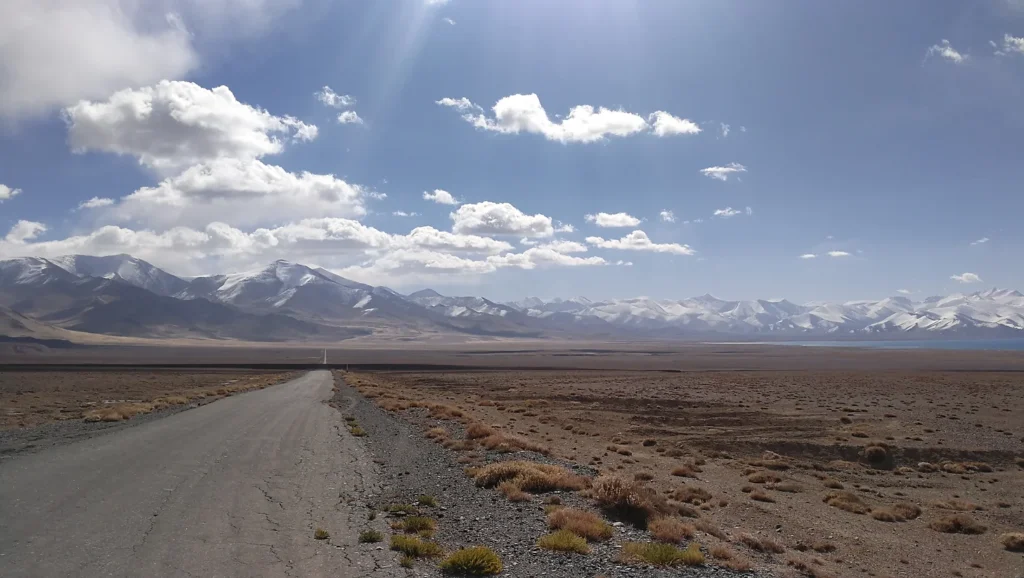
I passed a 4,250 meter pass on the way to the border – it’s funny how fast you get used to new surroundings … it felt like just another hill to cycle over and as I hadn’t checked the elevation profile before I only realized this pass existed when I was there.
Cool plateau stretch between two passes. From the left came an icy wind, perhaps a greeting from Lenin peak (7,134 meter) which is Tajikistan’s second highest peak after Ismoil Somoni (7,495 meter) – my mountaineer heart greeted back.

During the climb to the second pre-border pass, the ground switched from rock to earth – near border crossings it’s often the case they the geology or vegetation changes.
I was surprised that there was so much “open earth” lying around without erosion by the wind and rain – perhaps something even grows here in summer? Nature is strong …
Tajikistan, thank you for the impulses on growth. On our further consciousness expedition, perhaps it’s a good idea to remember that we all grow constantly in may ways … and that we can shape our growth with our reality-bending force.

